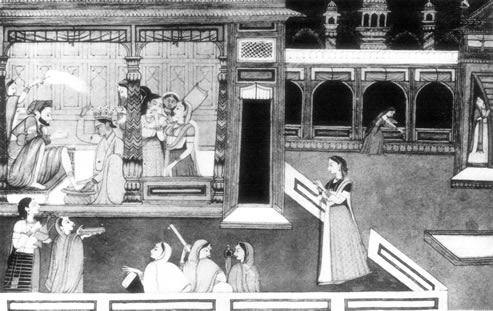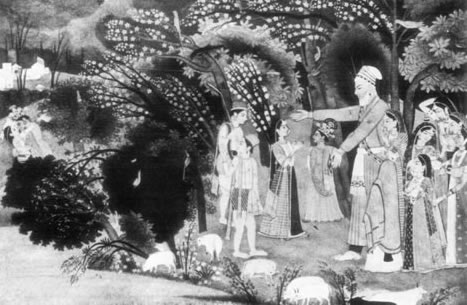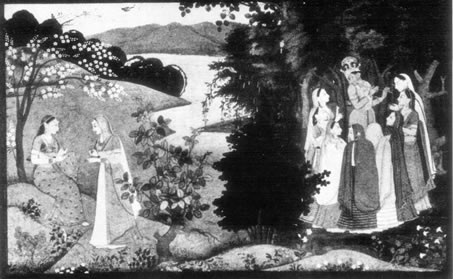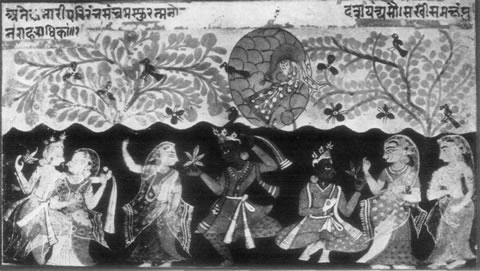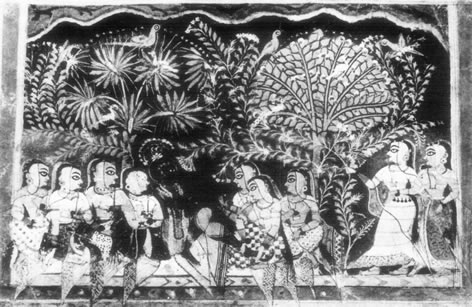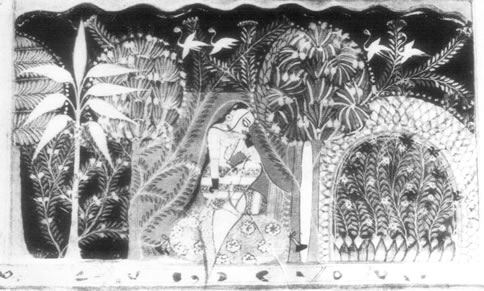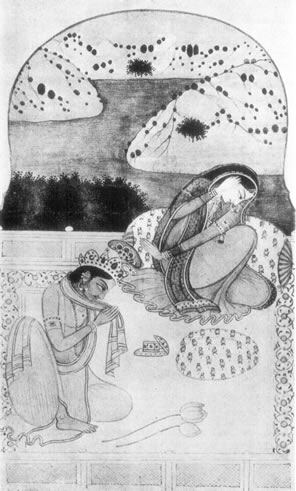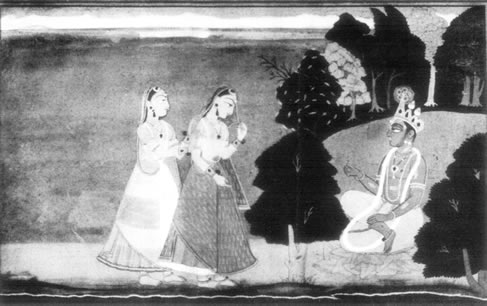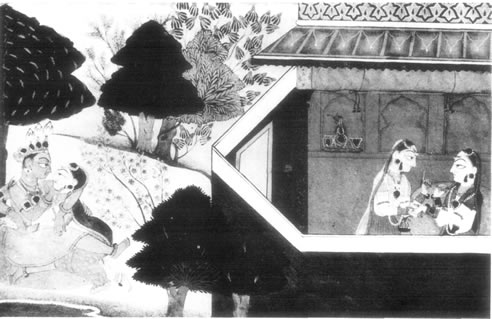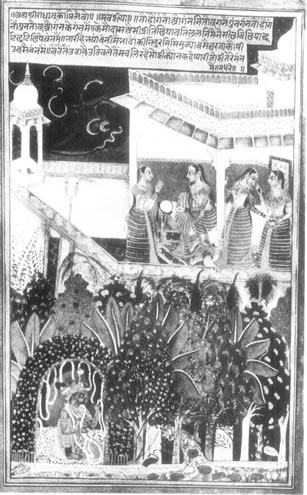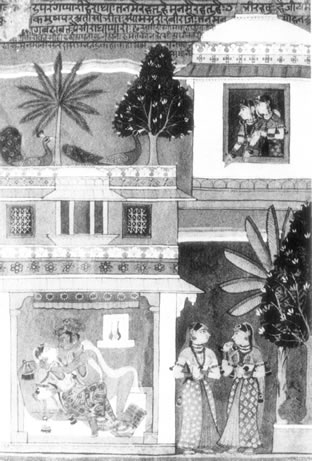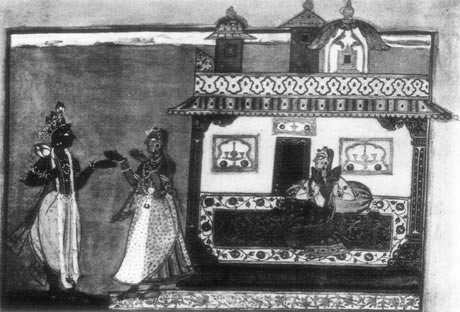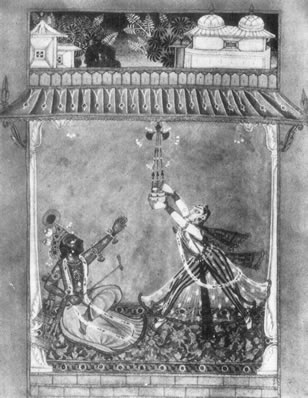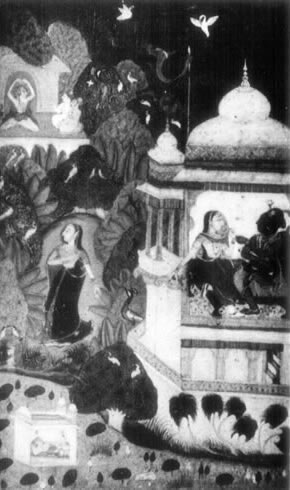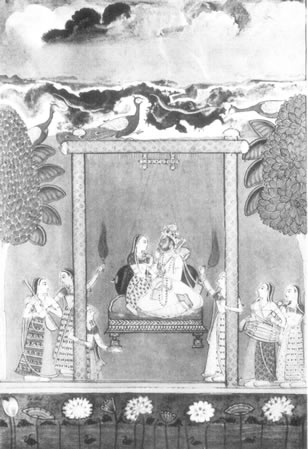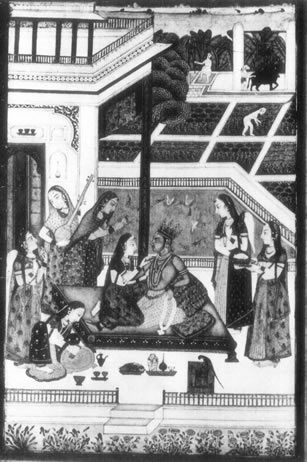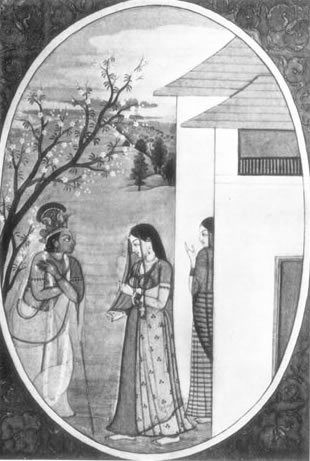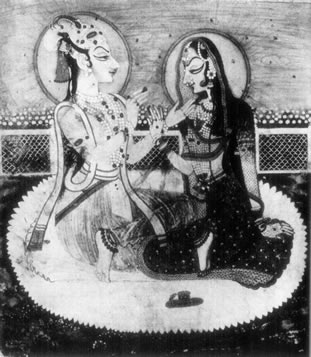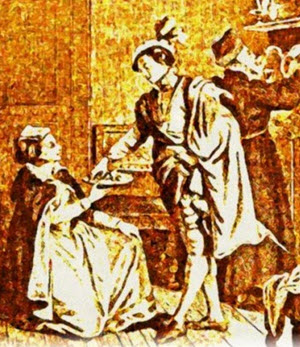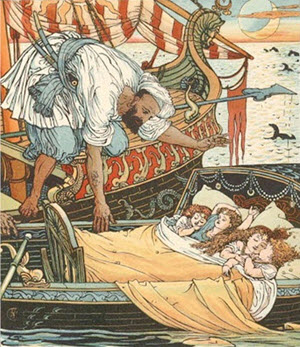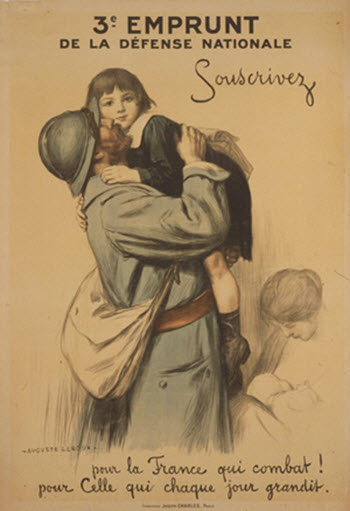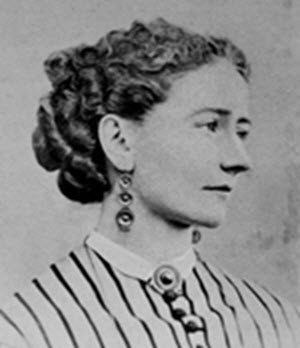Book Lover >> Loves of Krishna >> Chapter 6
Previous: Chapter 5
VI
THE KRISHNA OF PAINTING
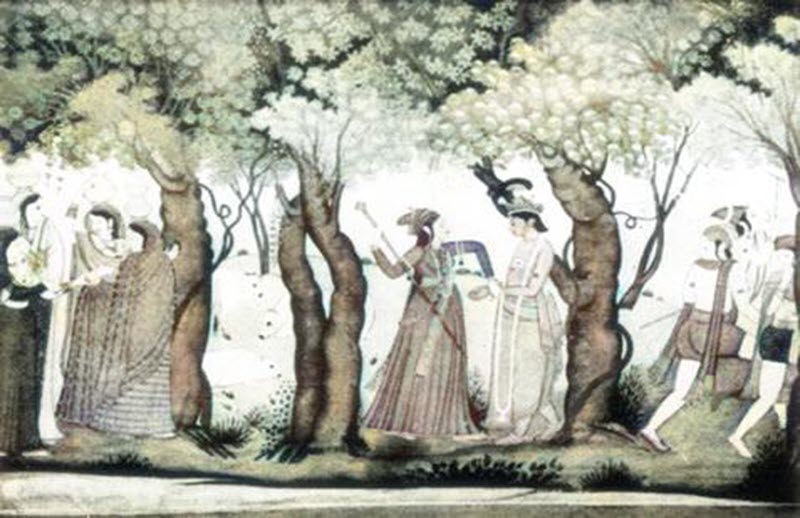
Radha disguised as a Constable arresting Krishna as a Thief

Illustration to a poem from the Sat Sai of Bihari
Kangra, Punjab Hills, c. 1790
>
Indian pictures of Krishna confront us with a series of difficult problems. The most exalted expressions of the theme are mainly from Kangra, a large Hindu state within the Punjab Hills.[66] It was here that Krishna, the cowherd lover, was most fully celebrated. Pictures were produced in large numbers and the Kangra style with its delicate refinement exactly mirrored the enraptured poetry of the later cult. This painting was due entirely to a particular Kangra ruler, Raja Sansar Chand (1775-1823)—his delight in painting causing him to spare no cost in re-creating the Krishna idyll in exquisite terms. Elsewhere, however, conditions varied. At the end of the sixteenth century, it was not a Hindu but a Muslim ruler who commissioned the greatest illustrations of the story. In the seventeenth and eighteenth centuries, Hindu patrons were the rule but in certain states it was junior members of the ruling family rather than the Raja himself who worshipped Krishna. Sometimes it was not the ruling family but members of the merchant community who sponsored the artists and, occasionally, it was even a pious lady or devout princess who served as patron. Such differences of stimulus had vital effects and, as a consequence, while the cult of Krishna came increasingly to enthrall the northern half of India, its expression in art was the reverse of neat and orderly. Where a patron was so imbued with love for Krishna that adoration of the cowherd lover preceded all, the intensity of his feeling itself evoked a new style. There then resulted the Indian equivalent of pictures by El Greco, Grunewald or Altdorfer—paintings in which the artist's own religious emotions were the direct occasion of a new manner. In other cases, the patron might adhere to Krishna, pay him nominal respect or take a moderate pleasure in his story but not evince a burning enthusiasm. In such cases, paintings of Krishna would still be produced but the style would merely repeat existing conventions. The pictures which resulted would then resemble German paintings of the Danube or Cologne schools—pictures in which the artist applied an already mature style to a religious theme but did not originate a fresh mode of expression. Whether the greatest art resulted from the first or second method was problematical for the outcome depended as much on the nature of the styles as on the artist's powers. In considering Indian pictures of Krishna, then, we must be prepared for sudden fluctuations in expression and abrupt differences of style and quality. Adoration of Krishna was to prove one of the most vital elements in village and courtly life. It was to capture the imagination of Rajput princes and to lead to some of the most intimate revelations of the Indian mind. Yet in art its expression was to hover between the crude and the sensitive, the savage and the exquisite. It was to stimulate some of the most delicate Indian pictures ever painted and, at the same time, some of the most forceful.
The first pictures of Krishna to be painted in India fall within this second category. In about 1450, one version of the Gita Govinda and two of the Balagopala Stuti were produced in Western India.[67] They were doubtless made for middle-class patrons and were executed in Western India for one important reason. Dwarka, the scene of Krishna's life as a prince, and Prabhasa, the scene of the final slaughter, were both in Western India. Both had already become centres of pilgrimage and although Jayadeva had written his great poem far to the East, on the other side of India, pilgrims had brought copies with them while journeying from Bengal on visits to the sites. The Gita Govinda of Jayadeva had become in fact as much a Western Indian text as the Balagopala Stuti of Bilvamangala. With manuscript illustrations being already produced in Western India—but not, so far as we know, elsewhere—it was not unnatural that the first illustrated versions of these poems should be painted here. And it is these circumstances which determined their style. Until the fifteenth century the chief manuscripts illustrated in Western India were Jain scriptures commissioned by members of the merchant community. Jainism had originated in the sixth century B.C. as a parallel movement to Buddhism. It had proved more accommodating to Hinduism, and when Buddhism had collapsed in Western India in the ninth century A.D., Jainism had continued as a local variant of Hinduism proper. Jain manuscripts had at first consisted of long rectangular strips made of palm-leaves on which the scriptures were written in heavy black letters. Each slip was roughly three inches wide and ten long and into the text had been inserted lean diagrammatic paintings either portraying Mahavira, the founder of the cult, or illustrating episodes in his earthly career.
About 1400, palm-leaf was superseded by paper and from then onwards manuscripts were given slightly larger pages. Owing partly to their association with the same religious order and partly to their constant duplication, Jain manuscripts had early conformed to a certain rigid type. The painting was marked by lean and wiry outlines, brilliant red and blue and above all by an air of savage ferocity expressed through the idiom of faces shown three-quarter view with the farther eye detached and projecting into space. This style was exercised almost exclusively on Jain subjects and in the year 1400 it was the main style of painting in Western India and Raj as than.
During the fifteenth century, this exclusive character gradually weakened. There arose the idea that besides Jain scriptures, secular poetry might also be illustrated and along with the growing devotion to Krishna as God came the demand for illustrated versions of Krishna texts. The three texts we have just mentioned are due to this tendency. All three are illustrated in the prevailing Jain style with its spiky angular idioms and all three have the same somewhat sinister air of barbarous frenzy. At the same time, all disclose a partial loosening of the rigid wiry convention, a more boisterous rhythm and a slightly softer treatment of trees and animals; and, although no very close correlation is possible, the theme itself may well have helped to precipitate these important changes.
Between 1450 and 1575, Western Indian painting continued to focus on Jain themes, adulterated to only a very slight extent by subjects drawn from poetry. It is possible that the Krishna story was also illustrated, but no examples have survived; and it is not until the very end of the sixteenth century that the Krishna theme again appears in painting and then in two distinct forms. The first is represented by a group of three manuscripts—two of them dated respectively 1598[68] and 1610[69] and consisting of the tenth book of the Bhagavata Purana, the third being yet another illustration of the Gita Govinda[70]. All three sets of illustrations are in a closely similar style—a style which, while possessing roots in Jain painting is now considerably laxer and more sprawling. The faces are no longer shown three-quarter view, the detached obtruding eye has gone and in place of the early sharpness there is now a certain slovenly crudity. We do not know for whom these manuscripts were made nor even in what particular part of Western India or Rajasthan they were executed. They were clearly not produced in any great centre of painting and can hardly have been commissioned by a prince or merchant of much aesthetic sensibility. They prove, however, that a demand for illustrated versions of the Krishna story was persisting and suggest that even prosperous traders may perhaps have acted as patrons.
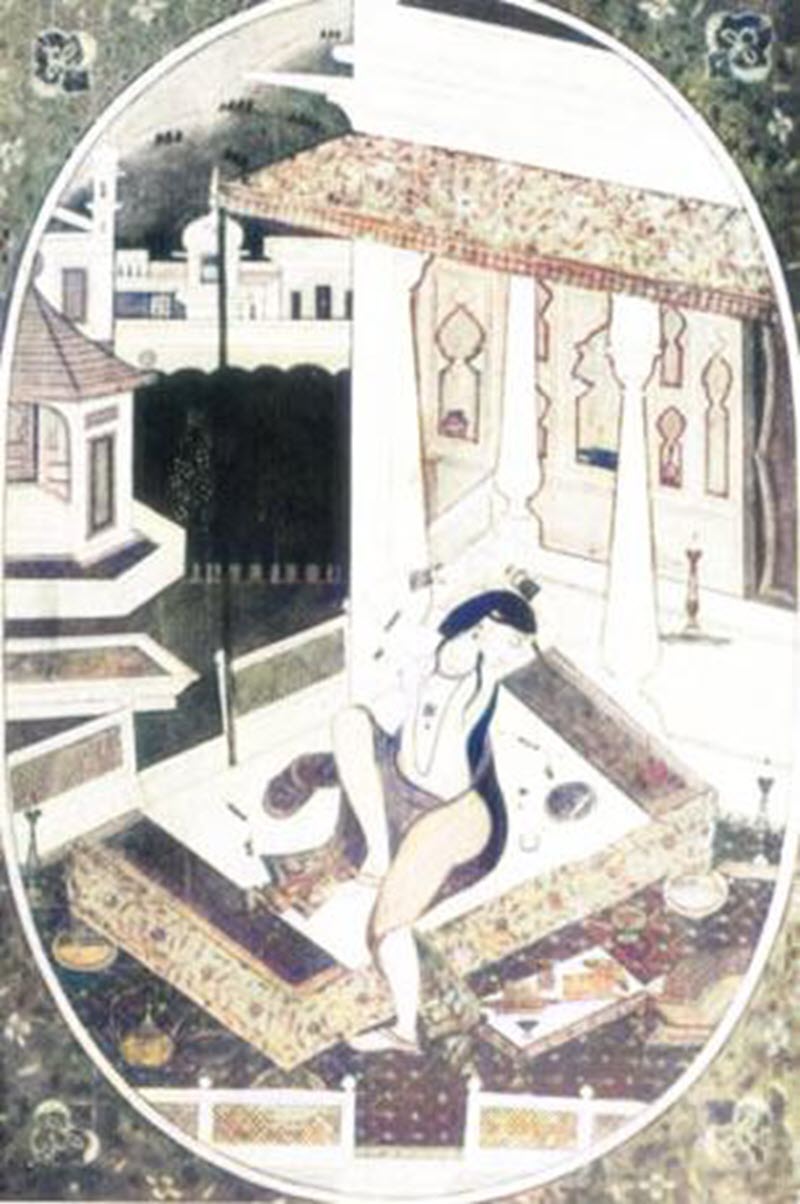
Radha's Longing
The second type is obviously the product of far more sophisticated influences. It is once again a copy of the Gita Govinda and was probably executed in about 1590 in or near Jaunpur in Eastern India. As early as 1465, a manuscript of the leading Jain scripture, the Kalpasutra, had been executed at Jaunpur for a wealthy merchant.[71] Its style was basically Western Indian, yet being executed in an area so far to the east, it also possessed certain novelties of manner. The heads were more squarely shaped, the eyes larger in proportion to the face, the ladies' drapery fanning out in great angular swirls. The bodies' contours were also delineated with exquisitely sharp precision. The court at the time was that of Hussain Shah, a member of the marauding Muslim dynasties which since the twelfth century had enveloped Northern India; and it is possibly due to persistent Muslim influence that painting revived in the last two decades of the sixteenth century. Illustrated versions of passionate love poetry were executed[72] and as part of the same vogue for poetic romance, the Gita Govinda may once again have been illustrated.[73] Between the style of these later pictures and that of the Jain text of 1465, there are such clear affinities that the same local tradition is obviously responsible. Yet the new group of paintings has a distinctive elegance all its own. As in the previous group, the detached projecting eye has gone. Each situation is treated with a slashing boldness. There is no longer a sense of cramping detail and the flat red backgrounds of Western Indian painting infuse the settings with hot passion. But it is the treatment of the feminine form which charges the pictures with sophisticated charm. The large breasts, the sweeping dip in the back, the proud curve of the haunches, the agitated jutting-out of the skirts, all these convey an air of vivid sensual charm. That Radha and Krishna should be portrayed in so civilized a manner is evidence of the power which the Krishna story had come to exercise on courtly minds. Krishna is portrayed not as God but as the most elegant of lovers, Radha and the cowgirls as the very embodiment of fashionable women.
Jaunpur painting does not seem to have survived the sixteenth century and for our next illustrations of the theme, we must turn to the school of painting fostered by the Mughals. During the sixteenth century at least three Muslim states other than Jaunpur itself had possessed schools of painting—Malwa in Central India and Bijapur and Ahmadnagar in the Deccan. Their styles can best be regarded as Indian offshoots of a Persian mode of painting which was current in the Persian province of Shiraz in about the year 1500. In this style, known as Turkman, the flat figures of previous Persian painting were set in landscapes of rich and glowing herbage, plants and trees being rendered with wild and primitive vigour. In each case the style was probably brought to India by Persian artists who communicated it to Indian painters or themselves adjusted it to local conditions. And it is this process which was repeated but on an altogether grander scale by the Muslim dynasty of the Mughals. Under the emperor Akbar (1556-1605), the Mughals absorbed the greater part of Northern India, concentrating in one imperial court more power and wealth than had probably been amassed at any previous time in India. Among Akbar's cultural institutions was a great imperial library for which a colony of artists was employed in illustrating manuscripts in Persian. The founders of this colony were Persian and it is once again a local style of Persian painting which forms the starting point. This style is no longer the Turkman style of Shiraz but a later style—a local version of Safavid painting as current in Khurasan. With its lively and delicate naturalism it not only corresponded to certain predilections of the emperor Akbar himself, but seems also to have appealed to Indian artists recruited to the colony. Its representational finesse made it an ideal medium for transcribing the Indian scene and the appearance at the court of European miniatures, themselves highly naturalistic, stimulated this character still further. The result was the sudden rise in India, between 1570 and 1605, of a huge new school of painting, exquisitely representational in manner and committed to a new kind of Indian naturalism. Such a school, the creation of an alien Muslim dynasty, would at first sight seem unlikely to produce illustrations of Hindu religion. Its main function was to illustrate works of literature, science and contemporary history—a function which resulted in such grandiose productions as the Akbarnama or Annals of Akbar, now preserved in the Victoria and Albert Museum.[74] None the less there are two ways in which Mughal painting, as developed under Akbar, contributed to the Krishna story. Akbar, although a Muslim by birth, was keenly interested in all religions and in his dealings with the Rajputs had shown himself markedly tolerant. He desired to minimise the hatred of Muslims for Hindus and believing it to arise from mutual ignorance, ordained that certain Hindu texts should be translated into Persian and thus rendered more accessible. The texts chosen were the two epics, the Ramayana and the Mahabharata, and of these Persian abridgements were duly prepared. The abridgement of the Mahabharata, known as the Razmnama, was probably completed in 1588 but illustrated copies, including the great folios now in the palace library at Jaipur, were probably not completed before 1595. As part of the project, its appendix, the Harivansa was also summarized and a separate volume with fourteen illustrations all concerned with Krishna is part of the great version now at Jaipur.[75] In these illustrations, it is Krishna the prince who is chiefly shown, all the pictures illustrating his career after he has left the cowherds. There is no attempt to stress his romantic qualities or to present him as a lover. He appears rather as the great fighter, the slayer of demons. Such a portrayal is what we might perhaps expect from a Mughal edition. None the less the paintings are remarkable interpretations, investing Krishna with an air of effortless composure, and exalting his princely grace. The style is notable for its use of smoothly flowing outlines and gentle shading, and although there is no direct connection, it is these characteristics which were later to be embodied in the Hindu art of the Punjab Hills.
Such interest by the Emperor may well have spurred Hindu members of the court to have other texts illustrated for, ten to fifteen years later, in perhaps 1615, a manuscript of the Gita Govinda was produced, its illustrations possessing a certain fairy-like refinement.[76] Krishna in a flowing dhoti wanders in meadows gay with feathered trees while Radha and her confidante appear in Mughal garb. Romance is hardly evident for it is the scene itself with its rustic prettiness which is chiefly stressed. Yet the patron by whom this version was commissioned may well have felt that it was sensitively rendered and within its minor compass expressed to some extent the magical enchantment distilled by the verses. That the Emperor's stimulus survived his death is plain; for in about the year 1620, two manuscripts of the Bhagavata Purana appeared—both in a style of awkward crudity in which the idioms of Akbar's school of artists were consciously aped.[77] The manuscripts in question are at Bikaner and it is possible that one or two inferior Mughal artists, deprived of work at the central court, travelled out to this northerly Rajput state, daring the desert, and there produced these vapid works. It is likely that in the early years of the seventeenth century, many areas of India possessed no artists whatsoever and if a Hindu ruler was to copy Mughal fashion, the only artists available to him might be those of an inferior rank. And although exact data are wanting, such circumstances may well explain another document of Krishna, the first illustrated version of Keshav Das's Rasika Priya.[78] As we have seen, this poem was composed at Orchha in Bundelkhand in 1591, at a time when both poet and court were in close association with Akbar. Yet the version in question shows the same poverty-stricken manner with its crude aping of imperial idioms and utter lack of sensitive expression. There is no evidence that at this time Bundelkhand possessed its own school of painting and in consequence the most likely explanation is that yet another inferior artist trained in the early Mughal manner, migrated to the court and there produced this crude prosaic version. In none of these provincial Mughal pictures is there any feeling for Krishna as God or even as a character. The figures have a wooden doll-like stiffness, parodying by their evident jerkiness the exquisite emotions intended by the poet and we can only assume that impressed by the imperial example minor rulers or nobles encouraged struggling practitioners but in an atmosphere far removed from that of the great emperor.
Such paintings in a broken-down Akbari manner characterize the period 1615 to 1630. From then onwards Mughal painting, as it developed under the emperor Shah Jahan, concentrated on more courtly themes. The early interest in dramatic action disappeared and the demand for costly manuscripts, sumptuously illustrated, withered up. Under Aurangzeb, tolerant understanding gave way to a vicious proselytism and it was only in remote centres such as Bikaner that later Mughal artists exercised their style on Krishna themes. It is significant that at Bikaner their leader was a Muslim, Ruknuddin, and that his chief work was a series of pictures illustrating the Rasika Priya.[79] His figures have a shallow prettiness of manner, stamping them once again as products of a style which, in its earliest phases, was admirably suited to recording dramatic action but which had little relevance to either religion or romance. For these a more poetic and symbolic manner was necessary and such a style appeared in the city of Udaipur in the Rajput State of Mewar.
Painting at Udaipur is inseparably associated with the influence of two great rulers—Rana Jagat Singh (1628-1652) and Rana Raj Singh (1652-1681) As early as 1605 pictures had been produced at the State's former capital, Chawand—the artist being a Muhammadan named Nasiruddin. His style was obviously quite independent of any Mughal influence and it is rather to the separate tradition of painting which had grown up in Malwa that we must look for its salient qualities—a tensely rhythmical line, a flamboyant use of strong emphatic colours, vigorous simplifications and boldly primitive idioms for plants and trees. It is this style which thirty or forty years later comes to luxuriant maturity in a series of illustrations executed at Udaipur.[80] Although the artists responsible included a Muslim, Shahabaddin, and a Hindu, Manohar, it is the Krishna theme itself which seems to have evoked this marvellous efflorescence. Rana Jagat Singh was clearly a devout worshipper whose faithful adhesion to Rajput standards found exhilarating compensations in Krishna's role as lover. Keshav Das's Rasika Priya achieved the greatest popularity at his court—its blend of reverent devotion and ecstatic passion fulfilling some of the deepest Rajput needs. Between the years 1645 and 1660 there accordingly occurred a systematic production not only of pictures illustrating this great poetic text but of the various books in the Bhagavata Purana most closely connected with Krishna's career. Krishna is shown as a Rajput princeling dressed in fashionable garb, threading his way among the cowgirls, pursuing his amorous inclinations and practising with artless guile the seductive graces of a courtly lover. Each picture has a passionate intensity—its rich browns and reds, greens and blues endowing its characters with glowing fervour, while Krishna and the cowgirls, with their sharp robust forms and great intent eyes, display a brusque vitality and an eager rapturous vigour. A certain simplification of structure—each picture possessing one or more rectangular compartments—enhances this effect while the addition of swirling trees studded with flowers imbues each wild encounter with a surging vegetative rhythm. Krishna is no longer the tepid well-groomed youth of Mughal tradition, but a vigorous Rajput noble expressing with decorous vehemence all the violent longings denied expression by the Rajput moral code. Such pictures have a lyrical splendour, a certain wild elation quite distinct from previous Indian painting and we can only explain these new stylistic qualities by reference to the cult of Krishna himself. The realization that Krishna was adorable, that his practice of romantic love was a sublime revelation of Godhead and that in his worship lay release is the motive force behind these pictures and the result is a new style transcending in its rhythmical assurance and glowing ardour all previous achievements.
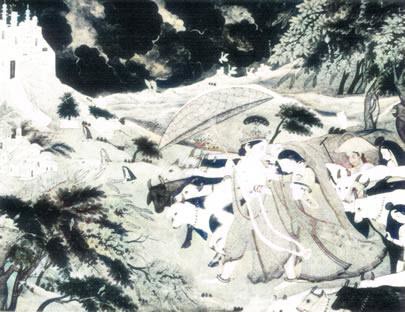
Radha and Krishna returning in the Rain
Such an outburst of painting could hardly leave other areas unaffected and in the closing quarter of the seventeenth century, not only Bundi, the Rajput State immediately adjoining Udaipur to the east, but Malwa, the wild hilly area farther south east, witnessed a renaissance of painting. At Bundi, the style was obviously a direct development from that of Udaipur itself—the idioms for human figures and faces as well as the glowing colours being clearly based on Udaipur originals. At the same time, a kind of sumptuous luxuriance, a predilection for greens and oranges in brilliant juxtaposition, a delight in natural profusion and the use of recessions, shading and round volumes give each picture a distinctive aura.[81] In Malwa, on the other hand, the earlier tradition seems to have undergone a new resuscitation. Following various wars in Middle India, the former Muslim kingdom had been divided into fiefs—some being awarded to Rajput nobles of loyalty and valour. The result was yet another style of painting—comparable in certain ways to that of Bundi and Udaipur yet markedly original in its total effect. In place of tightly geometrical compositions, Malwa artists preferred a more fluid grouping, their straining luxuriant trees blending with swaying creepers to create a soft meandering rhythm and only the human figures, with their sharply cut veils and taut intense faces, expressing the prevailing cult of frenzied passion.[82] Such schools of painting reflected the Rajput need for passionate romance rather than any specially strong adhesion to Krishna, the divine lover. Although one copy of the Rasika Priya and one of the Bhagavata Purana were executed at both these centres, their chief subjects were the ragas and raginis (the thirty-six modes of Indian music) nayakas and nayikas (the ideal lovers) and barahmasas (the twelve months) while in the case of Malwa, there was the added theme of Sanskrit love-poetry. Krishna the god was rarely celebrated and it was rather as 'the best of lovers' that he was sometimes introduced into pictures. In a Bundi series depicting the twelve months, courtly lovers are shown sitting in a balcony watching a series of rustic incidents proceeding below. The lover, however, is not an ordinary prince but Krishna himself, his blue skin and royal halo leaving no possible doubt as to his real identity.[83] Similarly in paintings illustrating the character and personality of musical modes, Krishna was often introduced as the perfect embodiment of passionate loving. None of the poems accompanying the modes make any allusion to him. Indeed, their prime purpose is to woo the presiding genius of the melody and suggest the visual scene most likely to evoke its spirit. The musical mode, Bhairava Raga, for example, was actually associated with Siva, yet because the character of the music suggested furious passion the central figure of the lover dallying with a lady was depicted as Krishna.[84] In Hindola Raga, a mode connected with swinging, a similar result ensued. Swinging in Indian sentiment was normally associated with the rains and these in turn evoked 'memory and desire.' The character of the music was therefore visualized as that of a young prince swinging in the rain—his very movements symbolizing the act of love. Since Krishna, however, was the perfect lover, nothing was easier than to portray Hindola Raga as Krishna himself. Hindola might be invoked in the poem, but it was Krishna who appeared seated on the swing.[85] An exactly similar process occurred in the case of Megh Mallar Raga. This was connected with the rainy season, yet because rain and storm were symbolic of sex, Megh Mallar was portrayed not as a separate figure, but as Krishna once again dancing in the rain with ladies accompanying him. Even feminine modes of music suffered the same kind of transformation. Vasanta Ragini, 'the music of springtime,' was normally apostrophized as a lovely lady, yet because springtime suggested lovers, she was shown in painting as if she were Krishna dancing with a vase of flowers, holding a wand in his hand or celebrating the spring fertility festival. The mode, Pancham Ragini, was also feminine in character and was conceived of as a beauty enjoying her lover's advances. The lady herself was portrayed, yet once again Krishna was introduced, this time as her lover. In all these cases the celebration of Krishna was incidental to the main theme and only in one instance—a Malwa Rasika Priya—is there a trace of undisguised adoration. In this lovely series,[86] Krishna's enchantment is perfectly suggested by the flowering trees which wave above him, the style acquiring an even more intense lyricism on account of its divine subject.
During the eighteenth century, painting in Rajasthan became increasingly secular, even artists of Udaipur devoting themselves almost exclusively to scenes of court life. The Ranas and the Mewar nobility were depicted hunting in the local landscape, watching elephant fights or moving in procession. Similar fashions prevailed in Jodhpur, Jaisalmer, Bikaner, Bundi and Kotah. Only, in fact, in two Rajasthan States and then for only brief periods was there any major celebration of the Krishna theme. At Kishangarh, a small State midway between Ajmer and Jaipur, a series of intensely poetic paintings were produced between the years 1750 and 1760—the prime stimulus being the delight of Raja Sawant Singh in Krishna's romance.[87] Born in 1699, Sawant Singh had ascended the throne in 1748 and given all his time to three activities, the rapturous re-living of Krishna's romance with Radha, the composition of ecstatic poems and the daily worship of Krishna as lover god. So great was his devotion that in 1757 he abandoned the throne and taking with him his favourite maid of honour, the beautiful poetess, Bani Thani, retired to Brindaban where he died in 1764. Sawant Singh's delight seems to have been shared by a local artist, Nihal Chand, for under the Raja's direction he produced a number of pictures in which Radha and Krishna sustained the leading roles. The pictures were mainly illustrations of Sawant Singh's own poems—the lovers being portrayed at moments of blissful wonder, drifting on a lake in a scarlet boat, watching fireworks cascading down the sky or gently dallying in a marble pavilion.
Here is Love's enchanted zone
Here Time and the Firmament stand still
Here the Bride and Bridegroom
Never can grow old.
Here the fountains never cease to play
And the night is ever young.[88]
Nihal Chand's style was eminently fitted to express this mood of sensitive adoration. Originally trained in the later Mughal style, he was able to render appearances with exquisite delicacy but was also acutely aware of rhythmical elegance. And it is this which constantly characterized his work, his greatest achievement being the creation of a local manner for portraying Radha and Krishna.[89] Radha was endowed with great arched eyebrows and long eyes—the end of the eye being tilted so as to join the downward sweeping line of the eyebrow while Krishna was given a slender receding forehead and narrow waist. Each was made to seem the acme of elegance and the result was a conception of Krishna and his love as the very embodiment of aristocratic breeding.
The same sense of aristocratic loveliness is conveyed by a scene of dancing figures almost life size in the palace library at Jaipur.[90] Painted under Raja Pratap Singh (1779-1803) the picture shows ladies of the palace impersonating Radha and Krishna dancing together attended by girl musicians.[91] Against a pale green background, the figures, dressed in greenish yellow, pale greyish blue and the purest white, posture with calm assured grace, while the pure tones and exquisite line-work invest the scene with gay and luminous clarity. We do not know the circumstances in which this great picture was painted but the existence of another large-scale picture portraying the circular dance—the lines of cowgirls revolving like flowers, with Radha and Krishna swaying in their midst—suggests that the Krishna theme had once again inflamed a Rajput ruler's imagination.[92]
Such groups of paintings are, at most, exquisite exceptions and it is rather in the Rajput states of the Punjab Hills—an area remote and quite distinct from Rajasthan—that the theme of Krishna the divine lover received its most enraptured expression in the eighteenth century. Until the second half of the seventeenth century this stretch of country bordering the Western Himalayas seems to have had no kind of painting whatsoever. In 1678, however, Raja Kirpal Pal inherited the tiny state of Basohli and almost immediately a new artistic urge became apparent. Pictures were produced on a scale comparable to that of Udaipur thirty years earlier and at the same time a local style of great emotional intensity makes its sudden appearance.[93] This new Basohli style, with its flat planes of brilliant green, brown, red, blue and orange, its savage profiles and great intense eyes has obvious connections with Udaipur paintings of the 1650-60 period. And although exact historical proof is still wanting, the most likely explanation is that under Rana Raj Singh some Udaipur artists were persuaded to migrate to Basohli. We know that Rajput rulers in the Punjab Hills were often connected by marriage with Rajput families in Rajasthan and it is therefore possible that during a visit to Udaipur, Raja Kirpal Pal recruited his atelier. Udaipur painting, however, can hardly have been the only source for even in its earliest examples Basohli painting has a smooth polish, a savage sophistication and a command of shading which suggests the influence of the Mughal style of Delhi. We must assume, in fact, a series of influences determined to a great extent by Raja Kirpal Pal's political contacts, his private journeys and individual taste, but perhaps above all by an urge to express his feelings for Krishna in a novel and personal manner. The result is not only a new style but a special choice of subject-matter. The Rasika Priya and the Bhagavata Purana, the texts so greatly favoured at Udaipur, were discarded and in their place Basohli artists produced a series of isolated scenes from Krishna's life—the child Krishna stealing butter,[94] Krishna the gallant robbing the cowgirls or exacting toll, Krishna extinguishing the forest-fire,[95] Krishna the violent lover devouring Radha with hungry eyes. Their greatest achievements, however, were two versions of Bhanu Datta's Rasamanjari, one of them completed in 1695,[96] shortly after Raja Kirpal Pal's death, the other almost certainly fifteen years earlier.[97] The text in question is a treatise on poetics illustrating how romantic situations should best be treated in Sanskrit poetry—the conduct of mature mistresses, experienced lovers, sly go-betweens, clowns or jokers being all subjected to analysis.[98] The subject of the text is secular romantic poetry and Krishna himself is never mentioned. None the less, in producing their illustrations, the artists made Krishna the central figure and we can only conclude that eschewing the obvious Rasika Priya, Raja Kirpal Pal had directed his artists to do for Sanskrit what Keshav Das had done for Hindi poetry—to celebrate Krishna as the most varied and skilled of lovers and as a corollary show him in a whole variety of romantic and poetic situations. As a result Krishna was portrayed in a number of highly conflicting roles—as husband, rake, seducer, paramour and gallant.
In one picture he is 'a gallant whose word cannot be trusted' and we see him in the act of delicately disengaging a lady's dress and gazing at her with passion-haunted eyes. The poem on the reverse runs as follows:
Showing her a beautiful girdle
Drawing on a fair panel with red chalk
Putting a bracelet on her wrists
And laying a necklace on her breasts
Winning the confidence of the fawn-eyed lady of fair brows
He slyly loosens the knot of her skirt
Below the girdle-stead, with naughty hand.[99]
In another picture, he appears as 'a gallant well versed in the ways of courtesans,' the dreaded seducer of inexperienced girls. He is now shown approaching a formal pavilion, set in a lonely field. Inside the pavilion is the lovely object of his attack, sitting with a companion, knowing that willy-nilly she must shortly yield yet timidly making show of maidenly reserve.
His swollen heart
Knows neither shame nor pity
Nor any fear of anger
How can such a tender bud as I
Be cast into his hands today?[100]
In yet a third picture, he is portrayed standing outside a house while the lady, the subject of his passions, sits within. He is once again 'a false gallant,' his amorous intentions being shown by the orange, a conventional symbol for the breasts, poised lightly in his hand. As the lady turns to greet him, she puts a dot in the circle which she has just drawn on the wall—a gesture which once again contains a hint of sex. On the picture's reverse the poem records a conversation galante.
'Beloved, what are you doing
With a golden orange in your hand?'
So said the moon-faced one
Placing a dot
On the bright circles
Painted in the house. [101]
In other pictures, a clown or jester appears, introducing a witty joking element into the scene and thus presenting Krishna's attitude to love as all-inclusive.
From 1693, the year of Raja Kirpal's death, painting at Basohli concentrated mainly on portraying rulers and on illustrating ragas and raginis—the poems which interpreted the moods and spirit of music. The style maintained its fierce intensity but there was now a gradual rounding of faces and figures, leading to a slight softening of the former brusque vigour. Devotion to Krishna does not seem to have bulked quite so largely in the minds of later Basohli rulers, although the cult itself may well have continued to exert a strong emotional appeal. In 1730, a Basohli princess, the lady Manaku, commissioned a set of illustrations to the Gita Govinda and Krishna's power to enchant not only the male but also the female mind was once again demonstrated.[102]
This series of illustrations is in some ways a turning point in Indian painting for not only was it to serve as a model and inspiration to later artists but its production brings to a close the most creative phase in Basohli art. After 1730, painting continued to be practised there but no longer with the same fervour. Basohli artists seem to have carried the style to other states—to Guler, Jammu, Chamba, Kulu, Nurpur and Bilaspur—but it is not until 1770 that the Krishna theme again comes into prominence. In about this year, artists from Guler migrated to the distant Garhwal, a large and straggling state at the far south of the Punjab Hills, taking with them a style of exquisite naturalism which had gradually reached maturity under the Guler ruler, Raja Govardhan Singh.[103] During his reign, a family of Kashmiri Brahmans skilled in the Mughal technique had joined his court and had there absorbed a new romantic outlook. On at least three occasions they had illustrated scenes from the Bhagavata Purana—Nanda celebrating Krishna's birth,[104] Krishna rescuing Nanda from the python which had started to devour his foot,[105] and finally the game of blind man's bluff[106]—but their chief subject had been the tender enchantments of courtly love. Ladies were portrayed longing for their lovers. The greatest emphasis was placed on elegance of pose. Fierce distortions were gradually discarded and the whole purpose of painting was to dwell on exquisite figures and to suggest a rapt devotion to the needs of love.
It is this suavely delicate art which now appears in Garhwal. Among the Guler painters was a master-artist and although his first Garhwal pictures are concerned with passionate romance, devotion to Krishna quickly becomes apparent.[107] The great Alaknanda River which roared through Srinagar, the capital, had a special fascination for him and just as Leonardo da Vinci evinced at one time a passionate interest in springing curls, the Guler artist found a special excitement in winding eddies and dashing water. The result was a sudden new interpretation of the Krishna theme. In two pictures where Krishna is shown quelling the snake Kaliya,[108] all the Guler qualities of elegant naturalism are abundantly present. Each figure has a smooth suavity and in every face there appears a look of calm adoration. It is the swirling, curling water, however, which gives the pictures their special Garhwal quality. The play of water evokes a melody of line and the result is a sense of upsurging joy. A similar religious exaltation marks other pictures by this master. At some time he appears to have been commissioned to illustrate the tale of Sudama the poor Brahman whose tattered hovel is changed by Krishna into a golden palace. He was evidently assisted by a weaker painter but in the pictures which are clearly his own work, the same quality of lyrical incantation appears. As Sudama journeys to Dwarka Krishna's golden city, his heart swoons with adoration, the hills, trees and ocean appear to dance about him and once again, the linear music of the composition engenders a feeling of supreme ecstasy.[109] We do not know which member of the Garhwal court acted as his patron—it is even possible that it was not the ruler himself but his consort, the Guler princess whom he had married in about the year 1770. What, at any rate, is clear is that at least one lively adorer of Krishna existed at the Garhwal court and that until the Gurkha invasions of 1803, there were other painters, besides the master-artist, who were similarly encouraged to interpret the Krishna theme.[110] Their style was clearly influenced by that of the master but in their use of slender leafless branches and towering spikes of blossom, they developed a special Garhwal imagery designed to suggest the slender beauty of love-enchanted girls. After the expulsion of the Gurkhas in 1816, a new Raja revived Garhwal painting. Krishna the lover was once again portrayed and until the middle of the nineteenth century, pictures continued to be produced blending the delights of courtly passion with adoration of God.
It was in the state of Kangra, however, that the greatest developments occurred. In 1775, the young Sansar Chand became Raja, and despite his extreme youth, quickly acquired mastery of the Kangra court. It is unlikely that artists were immediately summoned, but certainly by 1780 a flourishing school of painters had come into existence.[111] As at Garhwal, the artists of Kangra came originally from Guler and thus a similar phenomenon arises—the Guler manner providing the basis for yet a second great style. Sansar Chand was obviously quite exceptional, for not only was he successful in politics and war, but from his early manhood was devoted to Krishna as lover god. And it is this all-absorbing interest which explains the vast expansion of painting which now occurred. Under Sansar Chand's stimulus artists began to portray every situation involving Krishna, the cowherd. He was shown as a baby crying for the moon, being washed by his foster-mother, Yasoda, or mischievously breaking pitchers full of curds. He would be painted strolling with the cowherds, playing on his flute, or bringing the cattle home at evening. But the main theme to which the artists constantly returned was his main cowgirl love. Radha would be shown standing with Krishna in the forest, gazing trustfully into his eyes, seeking shelter with him from the rain or sitting with him by a stream.[112] Sometimes she and the cowgirls were shown celebrating the spring festival of Holi, Krishna syringing them with tinted water while they themselves strove to return his onslaughts by throwing red powder.[113] Often the scene would shift from the forest to the village, and Krishna would then be shown gazing at Radha as she dried herself after bathing or squatted in a courtyard cooking food. At other times he appeared assisting her at her toilet, helping her to dress her hair or applying a beauty mark to her forehead. If the scene was night itself, Radha would be shown sitting in her chamber, while far away across the courtyards and gardens would loom the small figure of Krishna waiting lonely on a bed. Occasionally the lovers would be portrayed expressing their rapture by means of simple gestures. Krishna's arm would be shown placed lovingly around Radha's shoulders, or Radha herself would be portrayed hiding her head on Krishna's breast.[114] In all these pictures, the style had an innocent and exquisite clarity, suggesting by its simple unaffected naturalism the artists' delight in Krishna's character, their appreciation of the feminine mind, their sense of sex as inherently noble and their association of romance with God himself.
It is in a series of illustrations to certain texts, however, that Kangra painting reaches its greatest heights. Among the many artists employed by Sansar Chand, a certain Purkhu was notable for his 'remarkable clearness of tone and delicacy of handling,'[115] and though none of his pictures are signed it is these qualities which characterize one of the two most famous sets of illustrations executed in Kangra. The subject was the tenth book of the Bhagavata Purana and the scenes illustrated ranged from Krishna's birth and adventures with demons to his frolics with the cowgirls and final slaughter of Kansa. Purkhu's style—if Purkhu is indeed the master responsible—is remarkable for its luminous clarity, its faint suggestions of modelling, and above all for its natural use of rhythm. In every scene,[116] cowherds appear engaged in different tasks, yet throughout there is a sense of oneness with Krishna himself. Krishna is shown delighting all by his simple friendliness and dignified charm and the style itself endows each scene with gentle harmony.
Purkhu was clearly one of the greatest artists ever to practise in the Punjab Hills, but it is a certain Kushala who is supposed to have been Sansar Chand's special favourite. We do not know which pictures are by his hand but there exist two series of illustrations of such distinctive quality that Kushala may well have been responsible.[117] One is a series of paintings illustrating part of Bihari's Sat Sai—the seven-hundred poems in which he extolled Krishna's love-making.[118] The other is yet another version of the Gita Govinda where Krishna is shown consorting with the cowgirls in blissful abandon.[119] In both these series, the inherent loveliness of Radha and the cowgirls is expressed by supple flowing line, a flair for natural posture and the inclusion of poetic images. The scarlet of a cowgirl's skirt is echoed by the redness of a gathering storm, the insertion of Krishna into the background suggesting the passionate nature of their imminent embraces.[120] In a similar way, the forest itself is 'threaded with phases of passion' and slender trees in flower parallel the slim romantic girls who long for Krishna's love.
One other Kangra master remains to be mentioned. Besides the pictures already noted, there exists a further series illustrating the tenth book of the Bhagavata Purana. The artist's identity is once again uncertain, but just as the Garhwal master was fascinated by the swirl of curling water, the Kangra artist in question delighted in the blonde pallor of the Indian moon.[121] Each incident in the text is rendered as if in moonlight—a full moon riding in the sky, its pale reflection shining in water, the countryside itself bathed throughout in frosty whiteness. As a result the figures of Radha and the cowgirls seem imbued with pallid glamour, their love for Krishna with an almost unearthly radiance.
Kangra painting continued throughout the nineteenth century but it was only during Sansar Chand's own reign (1775-1823) that the style achieved great lyrical glory. Similarly it was only towards the end of the eighteenth century that other states in the Punjab Hills developed their own interpretations of the great impassioned theme. At Nurpur, Chamba, Kulu and Bilaspur[122] pictures of Krishna had temporary vogues and at all these places artists created new modes of expression. None of the local styles, however, possessed the same prestige as that of Kangra and all were subsequently obliterated by the general Kangra manner. By the mid-nineteenth century, the Rajput order in the Punjab Hills foundered before the British and while lesser nobles and merchants continued to purchase pictures of Krishna the cult as a whole declined in princely favour. Only in Eastern India and then mainly in the villages did delight in Krishna continue to evoke new painting. From the twelfth century onwards Bengal had constantly celebrated the loves of Krishna—the poets Jayadeva, Chandi Das and Vidyapati being all natives of this part of India. Hymns to Krishna were sung in the villages and as part of this fervid adhesion, local manuscripts of the Bhagavata Purana and the Gita Govinda were often produced. Such manuscripts were normally not illustrated but were preserved between wooden covers, on which scenes of Krishna dancing with the cowgirls or with male devotees were painted.[123] Book covers of this kind were produced in the seventeenth and eighteenth centuries and the resulting pictures have something of the savage elation associated with the Basohli style and its derivatives. During the nineteenth century, painted book-covers ceased to be produced but three other kinds of painting continued to celebrate the Krishna theme. Frescoes of Hindu gods and goddesses including Krishna were often executed on the mud walls of village houses in Mithila, the birthplace of the poet Vidyapati, and the style of painting with its brilliant colours and brusque distortions testified to the great excitement still engendered by Krishna's name.[124] At Kalighat near Calcutta, a special type of water-colour picture was mass-produced for sale to pilgrims and although the stock subjects included almost every Hindu god, many incidents from Krishna's life were boldly portrayed.[125] The style with its curving sumptuous forms is more a clue to general Bengali interests than to any special attitudes to Krishna, but the pictures, strangely parallel in style to the work of the modern artist Fernand Léger, have a robust gaiety and bounding vigour, not inappropriate to the Krishna theme. The third type of painting is the work of professional village minstrels known as jadupatuas. As a means of livelihood, jadupatuas travel from village to village in West Bengal, entertaining the people by singing ballads and illustrating their songs with long painted scrolls. As each ballad proceeds, the scroll is slowly unwound, one scene leading to another until the whole is concluded. Among the ballads thus intoned, the romance of Krishna is among the most common and the style of painting with its crude exuberance suggests the strength of popular devotion.[126]
There remains one last form of painting. During the twentieth century, the modern movement in Indian art has produced at least four major artists—Rabindranath Tagore, Amrita Sher-Gil, Jamini Roy and George Keyt. Of these four, the first two did not illustrate the Krishna theme. Jamini Roy, on the other hand, has often painted Krishna as flute-player and dancer.[127] It would be unrealistic to suggest that these pictures spring from a lively sense of Krishna as God—Jamini Roy has, in fact, resorted to themes of Christ with equal, if not greater, frequency but has shown no signs of becoming a Christian. It is rather that in painting these pictures, he has treated Krishna as a symbol of rural vitality, a figure whose boisterous career among the cowherds is an exact reflection of his own attitudes and enthusiasms. To Jamini Roy, the Bengali village with its sense of rude health is infinitely to be preferred to a city such as Calcutta with its artificiality and disease and in a style of bold simplifications, he has constantly celebrated the natural vigour and inherent dignity of simple unsophisticated men.
Such pictures stress a comparatively unimportant side of Krishna's character and it is rather in the paintings of George Keyt that Krishna the lover is proudly portrayed. Born in Ceylon of mixed ancestry, Keyt has, for many years, been acutely responsive to Indian poetry. In 1947, he published the translation of the Gita Govinda, excerpts from which have been quoted in the text, and throughout his career his work has been distinguished by a poet's delight in feminine form and sensuous rapture. To Keyt such a delight is a vital component of adult minds and in the romance of Radha and Krishna he found a subject subtly expressive of his own most intimate beliefs. His paintings and line-drawings of Radha, Krishna and the cowgirls—at once modern yet vitally Indian in spirit—have the same qualities as those in the Gita Govinda.[128] Radha and Krishna are shown luxuriating in each other's elegance, a certain ineffable tenderness characterizing their gestures and movements. Their love is gentle rather than brusque, an air of glamorous wonder broods above them and we meet once more that blend of romantic sensuality and loving innocence which is perhaps the chief Indian contribution to cultured living. It is this quality which gives to Indian paintings of Krishna and his loves their incomparable fervour, and makes them enduring expressions of Indian religion.
[66] [67]M.R. Mazumdar, 'The Gujarati School of Painting,' Journal of the Indian Society of Oriental Art, 1942, Vol. X, plates 3 and 4.
Collection Maharaja of Jaipur, Pothikhana, Jaipur.
Collection Maharaja of Jodhpur, Pustakaprakash, Jodhpur Fort.
Plate 22. Collection N.C. Mehta, Bombay. For reproductions of 2 and 3, see Karl Khandalavala, 'Leaves from Rajasthan,' Marg, Vol. IV, No. 3. Figs. 8 and 10.
Moti Chandra, Jain Miniature Paintings from Western India (Ahmedabad, 1949), Figs. 99-105.
Khandalavala, op. cit., Fig. 14; The Art of India and Pakistan, Pls. 81 and 82.
For reproductions, see E. Wellesz, Akbar's Religious Thought reflected in Mogul Painting (London, 1952), Pls. 1-37.
The Art of India and Pakistan, Plate 88.
H. Goetz, The Art and Architecture of Bikaner State (Oxford, 1950), Fig. 91.
Coomaraswamy, Boston Catalogue, VI, Mughal Painting, Plates 8-19.
Goetz, op. cit., Figs. 78 and 93.
Plate 29. See also B. Gray, Treasures of Indian Miniatures from the Bikaner Palace Collection (Oxford, 1951), Plate 6.
The Art of India and Pakistan, Plate 85.
Plate 32.
Plate 34.
Plate 33.
Bharat Kala Bhawan, Banaras.
Eric Dickinson, 'The Way of Pleasure: the Kishangarh Paintings', 2 Marg, Vol. III, No. 4, 29-35.
Ibid., 31.
Plate 39.
For cartoons of this picture, see A.K. Coomaraswamy, Indian Drawings (London, 1912), Vol. II, Plate 2 and Rajput Painting, Vol. II, Plates 9 and 10.
Note 22.
Gangoly, Masterpieces of Rajput Painting, Plate 10.
Plate 4.
Plate 10.
Archer, Indian Painting in the Punjab Hills, Fig. 6.
Plate 30. Coomaraswamy, Boston Catalogue, V, Rajput Painting, Plates 92-95.
Note 23.
Coomaraswamy, Boston Catalogue, V, Rajput Painting, 171.
Ibid., 172.
Ibid., 173.
Archer, Garhwal Painting, 1-4.
Gangoly, op. cit., Plate 35.
Archer, Indian Painting in the Punjab Hills, Fig. 23.
Mehta, Studies in Indian Painting, Plate 21.
Coomaraswamy, Rajput Painting, Plates 53 and 54.
Archer, Garhwal Painting, Plate 1.
Archer, Kangra Painting, 2-5.
Ibid., Plate 2.
Ibid., Plate 1.
Ibid., Plate 2.
B.H. Baden Powell, Handbook of the Manufactures and Arts of the Punjab (Lahore, 1872), 355. Purkhu must now, most probably, be connected with the first of the two Kangra masters described in Kangra Painting (p. 4)—Plates 3 and 4 being examples of his work.
Archer, Kangra Painting, Plates 1 and 2; also p. 4 where the second of the two Kangra masters is described.
Plate 36; Mehta, op. cit., Plates 25 and 26.
Plate 21.
Mehta, op. cit., Plate 22.
Plate 18.
The Art of India and Pakistan, Plate 79
W.G. Archer, 'Maithil Painting,' Marg, Vol. III, No. 2.
W.G. Archer, Bazaar Paintings of Calcutta (London, 1953), Plates 8, 9, 14, 19, 30, 31 and 41.
Ajit Mookerjee, Art of India, (Calcutta, 1952) Fig. 94.
B. Dey and J. Irwin, 'Jamini Roy,' Journal of the Indian Society of Oriental Art (1944), Vol. XII, Plate 6.
For reproductions of Keyt's work, see Martin Russell, George Keyt (Bombay, 1950), Plates 1-101.
NOTES
Note 1, p. 13.
For a further discussion of these two main kinds of Indian expression, see my Indian Painting (Iris, Batsford, London, 1956).
Note 2, p. 14.
In Indian painting, Krishna is normally blue or mauve in colour, though cases occur in which he is black, green or dark brown. Black would seem to follow from Krishna's name—the word 'Krishna' meaning 'black'—and may have been applied either because he sprang from a black hair of Vishnu or because he was born at midnight, 'black as a thundercloud.' It has been suggested that his dark complexion proves a Dravidian or even an aboriginal origin since both the Dravidian races and the aboriginal tribes are dark brown in colour in contrast to the paler Aryans. None of the texts, however, appears to corroborate this theory. So far as 'blue' and 'mauve' are concerned, 'blue' is the colour of Vishnu and characterizes most of his incarnations. As the colour of the sky, it is appropriate to a deity who was originally associated with the sun—the sun with its life-giving rays according well with Vishnu's role as loving protector. 'Blue' is also supposed to be the colour of the ocean on which Vishnu is said to recline at the commencement of each age. In view of the variations in colour in the pictures, it is perhaps significant that 'blue,' 'mauve' and 'green' are commonly regarded in village India as variants of 'black'—many Indians making no distinction between them. In Indian painting, the fact that Krishna is blue makes it easy to identify him, his only serious rival being another and earlier incarnation of Vishnu, the princely Rama. The latter can usually be distinguished from Krishna by the fact that he carries a bow (never a cowherd's stick) and is often accompanied by Hanuman, the monkey leader.
Note 3, p. 17.
For a comparison of Ghora Angirasa's teaching in the Chandogya Upanishad with Krishna's precepts in the Gita, see Mazumdar, The Age of Imperial Unity (432-4) and Basham, The Wonder that was India (242-7, 304-5)
Note 4, p. 17.
Although the actual date of the Mahabharata war has been variously assessed—'between 1400 and 1000 B.C.' (M.A. Mehendale in The Age of Imperial Unity, 251) 'the beginning of the ninth century B.C. (Basham, op. cit., 39)—the epic itself is generally recognized as being a product of many centuries of compilation. The portions relating to Krishna the hero may well date from the third century B.C. The Gita, on the other hand, was possibly composed in the second century B.C. 'but assumed the form in which it appears in the Mahabharata today in the early centuries A.D.' (Mehendale, op. cit., 249).
Note 5, p. 24.
The implication is that the Pandavas have not been granted ultimate salvation i.e. final release from living but have reached the important transitional level of 'the heaven of the doers of good deeds.' They have also been granted the limited status of petty gods.
Note 6, p. 25.
Harivansa, 'the Genealogy of Krishna' but more literally, 'the Genealogy of Hari,' a synonym for Vishnu. For the sake of clearness and to avoid burdening the text with too much periphrasis, I have throughout referred to Krishna as such. In the texts themselves, however, he is constantly invoked under other names—Hari (or Vishnu), Govinda (the cowherd), Keshava (the hairy or radiant one), Janarddana (the most worshipful), Damodara ('bound with a rope,' referring to the incident (p. 32) when having been tied by Yasoda to a mortar, Krishna uproots the two trees), Murari ('foe of Mura, the arch demon' p. 58) or in phrases such as 'queller of Kaliya the snake,' 'destroyer of Kesi, the demon horse,' 'slayer of Madhu—the demon who sprang from the ear of Vishnu and was killed by him.' A similar use of periphrasis occurs in Anglo-Saxon kennings ('world-candle' for sun, 'battle-adders' for arrows). In the same way, Abul Fazl's chronicle, the Akbarnama, never names the emperor Akbar but refers to him in terms such as 'His Majesty,' 'the holy soul,' 'lord of the age,' 'fountain of generosity,' 'the sacred heart,' 'the world-adorning mind,' 'the decorated mansion of sports.'
Note 7, p. 26, 34, 46, 68, 69.
In Chapters 3 and 4 I have, in the main, strictly followed the Bhagavata Purana, incorporating, however, a few important details and passages either not given in this text but included in the Vishnu Purana or if given, not so vividly expressed. The details and passages in question are page 27 concerning the white and black hairs of Vishnu, page 34—the lyrical description of Krishna's life in the forest, page 46—Akrura's meditation as he goes to visit Krishna, page 68—the drunken brawl and page 69 the deaths of Balarama and Krishna. All extracts are from H.H. Wilson, The Vishnu Purana (pages 498, 511, 541-2, 609-612).
Note 8, p. 28.
The resemblance between Kansa's order to kill all male infants and Herod's slaughter of the innocents has often been remarked.
Note 9, p. 29.
Krishna's constant alterations of role, appearing sometimes as God but more often as boy or man, have been commented on by Isherwood and Prabhavananda in connection with Arjuna's dilemma in the Mahabharata. 'Krishna is the divine incarnation of Vishnu, Arjuna's chosen deity. Arjuna knows this—yet, by a merciful ignorance, he sometimes forgets. Indeed, it is Krishna who makes him forget, since no ordinary man could bear the strain of constant companionship with God. After the vision of Krishna's divine aspect, Arjuna is appalled by the realization that he has been treating the Lord of the universe as 'friend and fellow-mortal.' He humbly begs Krishna's pardon, but his awe soon leaves him. Again, he has forgotten. We may infer the same relationship between Jesus and his disciples after the vision of the transfiguration.' (The Song of God, Bhagavad-Gita, 29-30).
Note 10, p. 33.
Although part of the supreme Trinity, Brahma was often treated in literature as an ordinary god who ambled gently about the world, was often rather absent-minded, sometimes behaved as if he were a priest, and was prone, as on the present occasion, to act a trifle misguidedly.
Note 12, p. 40.
The scene is illustrated in two Kangra and Guler paintings (Archer, Indian Painting in the Punjab Hills, Figs. 10 and 23).
Note 12, p. 58.
Pragjyotisha—a city situated in the east, in Kamarupa on the borders of Assam. According to the Vishnu Purana (Wilson, 582), its environs were defended by 'nooses, constructed by the demon Mura (Naraka's ally), the edges of which were as sharp as razors.' Mura had seven thousand sons (not seven, as stated in the Bhagavata). All, however, were 'burnt like moths with the flame of the edge of Krishna's discus.'
Note 13, p. 67.
Basham (op. cit., 305) points out that elements in the Krishna story such as the destruction of the Yadavas and the death of the god are 'quite un-Indian in their tragic character. The themes of the drunken brawl leading to a general slaughter, of the hero slain by an arrow piercing his one vulnerable spot, and of the great city engulfed by the sea, are well-known in European epic literature, but do not occur elsewhere in that of India and are not hinted at in the Vedas. The concept of the dying god, so widespread in the ancient Near East, is found nowhere else in Indian mythology.'
It is unfortunate that Krishna's reasons for destroying the Yadava race are nowhere made very clear. The affront to the Brahmans is the immediate occasion for the slaughter but hardly its actual cause; and, if it is argued that the Yadavas must first be destroyed in order to render Krishna's withdrawal from the world complete, we must then assume that the Yadavas are in some mysterious way essential parts of Krishna himself. Such a status, however, does not seem to be claimed for them and none of the texts suggest that this is so. The slaughter, therefore, remains an enigma.
Note 14, p. 68.
Wilson (op. cit., 608) summarizing the portents listed in the Mahabharata but not included in the Vishnu or Bhagavata Puranas.
Note 15, p. 72.
From the Brihadaranyaka, quoted A. Danielou, 'An Approach to Hindu Erotic Sculpture,' Marg, Vol. II, No. i, 88. For a Western expression of this point of view, compare Eric Gill, 'Art and Love,' Rupam (Calcutta, 1925), No. 21, 5.
'If the trees and rocks, the thunder and the sea, the frightful avidity of animal life and the loveliness of flowers are so many hints of the God who made them, how much more obviously are the things of humanity analogues of the things of God? And among all such things, the union of man and woman takes the highest place and is the most potent symbol. Therefore it is that outside the commercial civilizations of the western world, love and marriage take their place as types of divine union and everywhere love and marriage are the subject matter, the theme of religious writers, singers, painters and sculptors. It is true that love is the theme of western writers also but with them the idea of love is entirely free from divine signification. (As a corollary), the more the divine background disappears, the more the prudishness of the police becomes the standard of ethics and aesthetics alike. Under such an aegis the arts are necessarily degraded to the level of the merely sentimental or the merely sensual and while the sentimental is everywhere applauded, the sensual is a source of panic.'
Note 16, p. 73.
In later poetry as well as in popular worship, Radha's position is always that of an adored mistress—never that of a beloved wife. And it is outside or rather in the teeth of marriage that her romance with Krishna is prosecuted. Such a position clearly involved a sharp conflict with conventional morals and in the fourteenth century, an attempt was made, in the Brahma Vaivarta Purana, to re-write the Bhagavata Purana, magnifying Radha as leader of the cow-girls, disguising or rather denying her adultery and finally presenting her as Krishna's eternal consort. For this purpose, three hypotheses were adopted. Radha was throughout assumed to be Krishna's spouse and it is only on account of a curse that she takes human form as a cowgirl and comes to live in Brindaban. Radha herself does not marry Ayana the cowherd—his wedding being only with her shadow. Thirdly, Krishna comes to Brindaban and goes through a secret marriage with her. Their love-making is, therefore, no longer adulterous but strictly conjugal. It is not perhaps surprising that the Brahma Vaivarta Purana failed to capture the Indian imagination and indeed is nowadays hardly ever heard of. It is of interest mainly on account of the prolific information given about Radha, the fact that it sets her firmly in the centre, dethroning the hapless Rukmini, and its baroque descriptions of sexual union.
Note 17, p. 73.
During the eleventh and twelfth centuries, a parallel situation seems to have arisen in feudal France and Germany where local love-poetry also treated adultery as a sine qua non of romance.
'Two things prevented the men of that age from connecting their ideal of romantic and passionate love with marriage. The first is, of course, the actual practice of feudal society. Marriages had nothing to do with love and no 'nonsense' about marriage was tolerated. All marriages were matches of interest and, worse still, of an interest that was continually changing. When the alliance which had answered would answer no longer, the husband's object was to get rid of the lady as quickly as possible. Marriages were frequently dissolved. The same woman who was the lady and 'the dearest dread' of her vassals was often little better than a piece of property to her husband. He was master in his own house. So far from being a natural channel for the new kind of love, marriage was rather the drab background against which that love stood out in all the contrast of its new tenderness and delicacy. The situation is indeed a very simple one, and not peculiar to the Middle Ages. Any idealization of sexual love, in a society where marriage is purely utilitarian, must begin by being an idealization of adultery.' (C.S. Lewis, The Allegory of Love (London, 1936), 13.)
Note 18, p. 77.
Much of the Gita Govinda's power arises from the endowment of Nature with romantic ardour, the forest itself being presented as a highly sensitive and symbolic setting for the behaviour of lovers. The following passage from Tess of the D' Urbervilles is perhaps the nearest approach in English to this kind of treatment.
'Amid the oozing fatness and warm ferments of the Var Vale, at a season when the rush of juices could almost be heard below the hiss of fertilization, it was impossible that the most fanciful love should not grow passionate. The ready bosoms existing there were impregnated by their surroundings. July passed over their heads and the weather which came in its wake seemed an effort on the part of Nature to match the state of hearts at Talbothays Dairy. The air of the place, so fresh in the spring and early summer, was stagnant and enervating now. Its heavy scents weighed upon them, and at mid-day the landscape seemed lying in a swoon. Ethiopic scorchings browned the upper slopes of the pastures, but there was still bright herbage here where the water courses purled. And as Clare was oppressed by the outward heats, so was he burdened inwardly by waxing fervour of passion for the soft and silent Tess.'
Note 19, p. 77.
The Gita Govinda was one of the first Sanskrit poems to be rendered into English—Sir William Jones publishing a mellifluous version in Asiatick Researches in 1792. Later in the nineteenth century it was translated into Victorian verse by Sir Edwin Arnold. The present translation from which all the extracts are taken is by George Keyt, the foremost modern artist of Ceylon. It is greatly to be hoped that the entire translation, hitherto available only in an Indian edition, will one day be published in England.
Note 20, p. 86.
Poems 1 and 2 are based on versions by O.C. Gangoly (Masterpieces of Rajput Painting, 29, 58); poems 3-11 are from new translations by Deben Bhattacharya.
Note 21, p. 91.
For the originals of certain poems in the Rasika Priya and their literal translation, see Coomaraswamy, 'The Eight Nayikas.'
Note 22, p. 104.
The first scholar to draw attention to this fact, i.e. that the subjects are not Radha and Krishna but palace ladies impersonating them, is Dr. Joan van Lohuizen de Leeuw, whose paper on this and kindred problems is under preparation.
Note 23, p. 105.
For a detailed discussion of Bhanu Datta's Rasamanjari and of similar treatises by other Sanskrit authors, see V. Raghavan, Srngaramanjari of Saint Akbar Shah (Hyderabad, 1951).
BIBLIOGRAPHY
AGRAWALA, V.S.: 'The Romance of Himachal Paintings,' Roopa-Lekha XX, 2, (1948-9), 87-93.
ARCHER, W.G.: Indian Painting in the Punjab Hills (London, 1952). Kangra Painting (London, 1952). Garhwal Painting (London, 1954). Indian Painting (London, 1956).
BASHAM, A.L.: The Wonder that was India (London, 1954).
BURNOUF, E. (trans.): Le Bhagavata Purana (Paris, 1840-98).
COOMARASWAMY, A.C.: 'The Eight Nayikas,' Journal of Indian Art and Industry, XVI (New Series), No. 128 (1914), 99-116. Rajput Painting (Oxford, 1916). Catalogue of the Indian Collections in the Museum of Fine Arts, Boston: Part V, Rajput Painting; Part VI, Mughal Painting (Cambridge, Mass. 1926, 1930). (trans.) The Taking of Toll (London, 1915).
GANGOLY, O.C.: Masterpieces of Rajput Painting (Calcutta, 1926). Ragas and Raginis (Calcutta, 1934).
GRAY, B.: Rajput Painting (London, 1948). 'Painting,' The Art of India and Pakistan, ed. L. Ashton (London, 1950).
GRIERSON, G.A.: The Modern Vernacular Literature of Hindustan (Calcutta, 1889).
HENDLEY, T.H.: Memorials of the Jeypore Exhibition. IV, the Razm Namah (London, 1883).
HOLLINGS, W. (trans.): The Prem Sagar (Lucknow, 1880).
ISHERWOOD, C. and PRABHAVANANDA, S.(trans.): The Song of God, Bhagavad-Gita (London, 1947).
JONES, W. (trans.): 'Gitagovinda or Songs of Jayadeva,' Asiatick Researches (Calcutta, 1792).
KEYT, G. (trans.): Sri Jayadeva's Gita Govinda (Bombay, 1947).
MATHERS, E. POWYS (trans.): Eastern Love (London, 1927-30). (trans.) Love Songs of Asia (London, 1944).
MAZUMDAR, R.C. (ed.): The History and Culture of the Indian People, I, The Vedic Age (London, 1951); II, The Age of Imperial Unity (Bombay, 1951).
MEHTA, N.C.: Studies in Indian Painting (Bombay, 1926). Gujarati Painting in the Fifteenth Century (London, 1931).
RANDHAWA, M.S.: Kangra Valley Painting (New Delhi, 1954). The Krishna Legend in Pahari Painting (New Delhi, 1956).
ROY, P.C. (trans.): The Mahabharata (Calcutta, 1883).
SEN, D.C.: History of Bengali Language and Literature (Calcutta, 1911).
SEN, R.N. (trans.): The Brahma Vaivarta Purana (Allahabad, 1920).
STCHOUKINE, I.: La Peinture Indienne (Paris, 1929).
WINTERNITZ, M.: A History of Indian Literature (Calcutta, I, 1927; II, 1933).
WILSON, H.H. (trans.): The Vishnu Purana (London, 1840).
INDEX
Abul Fazl, 116, pl. 1 (comment)
Aditi, mother of the gods, 58, 59
Age of Imperial Unity, The, 115, 121
Agni, god of fire, 18
Agrawala, V.S., 121
Ahmadnagar, Deccan, 97
Ajmer, Rajasthan, 103
Akbar, Mughal Emperor, 97-99, 116, pl. 1 (comment)
Akbarnama, 98, 116
Akrura, chief of the Yadavas, 45-47, 49, 51, 57, 116
Allegory of Love, The, 119
Altdorfer, 93
Amaru, Sanskrit poet, 73
Aniruddha, son of Pradyumna and grandson of Krishna, 64
Archer, Mildred, 4, 9
Archer, W.G., 4, 101, 105, 107-112, 115, 117, 121
Arjuna, leading Pandava, husband of Draupadi, husband of Krishna's sister, Subhadra, 20-22, 64, 65, 67, 69, 116, 117
Arnold, Sir Edwin, 119
Art of India and Pakistan, The, 96, 98, 101, 104, 107, 111, 121
Asiatick Researches, 119
Assam, 117
Aurangzeb, Mughal Emperor, 99
Ayana, husband of Radha, brother of Yasoda, 72, 118
Baden Powell, B.H., 110
Bakasura, crane demon, 33
Balagopala Stuti, poem by Bilvamangala, 84, 94
Balarama, brother of Krishna, 27, 30, 31, 34-36, 44-48, 50-56, 61-64, 66, 67, 69, 116, pls. 1, 5, 6, 9, 12, 16, 17
Bali, ruler of the underworld, 62
Bani Thani, poetess of Kishangarh, 103
Barahmasa, poems of the twelve months, 102, pl. 32
Basawan, Mughal artist, pls. 1, 2 (comment), 3 (comment)
Basham, A.L., 9, 19, 115, 117, 121
Basohli, Punjab Hills, 104, 105, 107, 111, pls. 18 (comment), 26 (comment), 30 (comment)
Beatty, Sir Chester, pls. 17, 19
Bhagavad Gita, 15-17, 24, 67, 115, 117
Bhagavata Purana, 11, 25-71, 72, 74, 85, 85, 99, 101, 105, 107, 110, 111, 116-18, 121, pls. 3-19
Bhakti, devotion to God, 19, 24
Bhanu Datta, author of Rasamanjari, 9, 105, 120, pls. 30, 31
Bharat Kala Bhawan, Banaras, 103, pl. 37
Bharatiya Natya Sastra, Sanskrit treatise, 90
Bhartrihari, Sanskrit poet, 73
Bhattacharya, Deben, 9, 87-90, 119
Bhima, strongest of the five Pandavas, 24, 65, 66
Bihari Lai, poet, 84, 110, pl. 36
Bijapur, Deccan, 97
Bikaner, Rajasthan, 99, 100, 103
Bilaspur, Punjab Hills, 107, 111, pl. 18
Bilvamangala, poet, 84, 94
Blue, colour of Krishna, 14, 115
Book covers, Bengali, 111
Brahma, 17, 27, 28, 33, 34, 58, 59, 65, 67, 117, pl. 2
Brahma Vaivarta Purana, 118, 121
Brahmans, 22, 28, 30, 38, 39, 62, 63, 67, 68, 71, 74, 107, 108, 117
Wives of, 38, 39
Braj, country around Mathura, 26, 28, 40
Brihadaranyaka, 117
Brindaban, forest near Gokula, 33, 35, 45, 46, 49, 52, 53, 59-62, 103, pl. 6
British Museum, pl. 18
Brough, J., 9
Buddhism, 94
Bull demon, 44
Bundelkhand, 91, 99
Bundi, Rajasthan, 101-103
Burnouf, E., 121
Calcutta, 111, 112
Campbell, Roy, 75
Ceylon, 57, 112
Chamba, Punjab Hills, 107, 111
Chandi Das, Bengali poet, 84, 85, 89, 111
Chandigarh Art Gallery, East Punjab, pl. 27
Chandogya Upanishad, 17, 24, 115
Chanura, wrestler, 45, 48
Chawand, Mewar, 100
Christ, 14, 112, 117
Clothes, stealing of cowgirls', 37, 38, 74, 75, pl. 11
Coomaraswamy, A.K., 99, 104-106, 108, 120, 121, pl. 8 (comment)
Cowgirls, loves of the, 29, 36-38, 41-44, 46, 49, 50, 52, 53, 58, 60-62, 66, 70-82, 85, 86, 109, 110, 113, pls. 11, 13-15, 20-23.
Cowherds, abandonment of, by Krishna,
Krishna's life with, 49-53, 61, 62
Damodara, pseudonym for Krishna, 116
Dance, circular, 38, 41, 43, 46, 74, 75, p. 13 (comment)
Danielou, A., 117
Daruka, charioteer to Krishna, 68, 69
Demons, combats with, 29, 30, 33-36, 44, 45, 54, 55, 58, 64, 116, 117, pl. 9
role of, 18, 19
Devaka, younger brother of King Ugrasena, 27
Devaki, mother of Krishna, 17, 27, 28, 44, 46, 48-50, 52, 63, 69, pl. 3
Devi, goddess, Earth Mother, 28, 40, 56, pls. 3, 18
Dey, B., 112
Dharma, 18, 23
Dhenuka, ass demon, 34
Dhritarashtra, blind son of Kuru, father of Kauravas, 20, 21, 51, 66
Dice, contest by, 21
Dickinson, Eric, 103
Draupadi, daughter of King of Panchal, common wife of the five Pandavas, 20-23, 64, 67
Drumalika, demon, 26
Duryodhana, leading Kaurava and son of Dhritarashtra, 23, 51, 66, 67
Dwarka, Krishna's capital in Western India, 21, 22, 54-59, 61-64, 66-70, 94, 108, pls. 2 (comment), 19
Earth, 27, 49, 58, 67
Eastern Love, 121
El Greco, 93
Flute playing, 15, 36, 37, 41, 61, 78, 86, 109, 112, pl. 21
Forest fires, 35, 36, pl. 10
France, feudal, 118
Games with cowherds, Krishna's, 31-35, 45, pls. 4-9
Gandhi, Mahatma, 15
Gangoly, O.C., 104, 119, 121
Garga, sage, 30, 31
Garhwal, Punjab Hills, 107-110, pl. 38
Garhwal Painting, 107, 108, 121
Germany, feudal, 118
Ghora Angirasa, 17, 115
Gill, Eric, 118
Gita Govinda, Sanskrit poem by Jayadeva, 9, 11, 76-84, 94-96, 98, 110, 111, 113, 119, 121, pls. 20-27
Gods, role of, 18, 19
Goetz, H., 99, 100
Gokula, district near Mathura, 26, 30, 33, 44
Govardhan Singh, Raja of Guler, 107
Govardhana, greatest of the hills, 39, 40, 42, 59, pl. 12
Govind Das, poet, 84, 88
Govinda, pseudonym for Krishna, 116
Gray, Basil, 100, 121
Grierson, Sir G.A., 121
Grunewald, 93
Gujarati Painting in the Fifteenth Century, 121
Guler, Punjab Hills, 107-109, pl. 18 (comment)
Hari, pseudonym for Krishna, 116
Harivansa, appendix to Mahabharata epic, 25, 32, 98, 116
Hendley, T.H., 98, 121
Herod, 116
Holi festival, 109
Hollings, W., 121
Hunter, slayer of Krishna, see Jara.
Hussain Shah, ruler of Jaunpur, 96
India Office Library, London, pl. 34 (comment)
Indian Museum, Calcutta, pl. 35
Indian Painting, 115, 121
Indian Painting in the Punjab Hills, 105, 107
Indra, king of the gods, lord of the clouds, 18, 24, 39, 40, 46, 58, 59, 65, 66, pls. 2, 12
Irwin, J., 112
Isherwood, Christopher, 15, 24, 116
Jadupatuas, minstrel artists of Bengal, 112
Jaipur, Rajasthan, 95, 98, 103, 104, pls. 1 (comment), 2 (comment)
Jaisalmer, Rajasthan, 103
Jambhavati, a queen of Krishna, 56, 57, 60
Jammu, Punjab Hills, 107
Janarddana, pseudonym for Krishna, 116
Japan, 13
Jara, Bhil hunter, slayer of Krishna, 24, 67, 69, pl. 2
Jarasandha, demon king of Magadha, 26, 54-56, 65
Jaunpur, Eastern India, 96, 97
Jayadeva, Sanskrit poet, 76, 77, 84, 94, 111, 121
Jodhpur, Rajasthan, 95, 103
Jones, Sir William, 119, 121
Jumna, river, 22, 28, 35, 37, 41, 43, 47, 48, 61, 74, 82, 85, pls. 8, 13-15
Kalidasa, Sanskrit poet, 73
Kalindi, a queen of Krishna, 57, 60, 64
Kaliya, giant hydra-headed snake, 35, 42, 46, 108, 116, pls. 8, 10 (comment)
Kaliyavana, 54
Kalpasutra, Jain Scripture, 96
Kama, god of passion, 18, 64
Kamalavati, mother of Radha, 72
Kangra, Punjab Hills, 93, 108-11, pl. 3 (comment)
Kangra Painting, 109, 110, 121
Kangra Valley Painting, 121
Kanoria, Gopi Krishna, 9, pls. 7, 29, 39
Kansa, tyrant king of Mathura, son of Pavanarekha by the demon Drumalika, 26-29, 31, 33, 43-50, 54, 55, 57, 62, 110, 116, pls. 3, 9 (comment), 16 (comment), 17, 35 (comment)
Karna, leading Kaurava killed by Arjuna at Kurukshetra, 23
Kauravas, the 100 sons of Dhritarashtra, rivals of the Pandavas (vide Mahabharata) 20, 21, 23, 26, 51, 62, 66, 67
Kennings, Anglo-Saxon, 116
Keshav Das, poet, 84, 91, 99, 100, 105, pls. 28, 30 (comment)
Keshava, pseudonym for Krishna, 116
Kesi, horse demon, 44, 45, 115
Keyt, George, artist and translator of the Gita Govinda, 9, 76-83, 112, 113, 119, 121, pls. 21-27 (comments)
Khandalawala, Karl, 95, 96, pls. 10, 23 (comment)
Khurasan, 97, pl. 1 (comment)
Kirpal Pal, Raja of Basohli, 104, 105, 107, pl. 10 (comment)
Kishangarh, Rajasthan, 103, pl. 39
Kotah, Rajasthan, 103
Krishna Das, poet, 84
Kubera, yaksha king, pl. 5 (comment)
Kubja, hunchback girl, 47, 53, 54
Kulu, Punjab Hills, 107, 111
Kumbhan Das, poet, 84
Kundulpur, 56
Raja of, father of Rukmini, 55
Kunti, wife of Pandu, mother of the Pandavas, sister of Vasudeva (Krishna's father), 20, 21, 51, 57, 62, 64
Kuru, common ancestor of the Pandavas and Kauravas, 20
Kurukshetra, battle-field of, 15, 21, 26, 61
Kushala, Kangra artist, 110, pls. 3, 21, 36
Kuvara, brother of Nala, 32, pl. 5
Lahore, State Museum, pl. 26
Lanka, modern Ceylon, 57
Léger, F., 112
Lewis, C.S., 119
Lohuizen, Dr. Joan van, de Leeuw, 120
Love Songs of Asia, 121
Lucknow, State Museum, pl. 5
MacNeice, Louis, 15
Madhu, demon, 116
Magadha, 26, 54, 55
Mahabharata, 11, 17, 19-25, 51, 70, 98, 115
Mahavira, founder of Jainism, 94
Malabar, 84
Malwa, Central India, 97, 100-102
Manaku, Basohli princess, patron of painting, 107, pl. 26 (comment)
Manohar, Mewar artist, 100
Marg, Indian art journal, 95, 103, 111, 117
Masterpieces of Rajput Painting, 104, 119, 121
Mathers, E. Powys, 121
Mathura, town in Northern India, 26, 29, 30, 38, 39, 44-55, 61, 74, 76, pls. 16 (comment), 17 (comment)
Mazumdar, M.R., 94
R.C., 115, 121
Mehendale, M.A., 115, 116
Mehta, N.C., 95, 107, 110, 121, pls. 4, 21, 22, 36
Mewar, Rajasthan, 100, 103
Mira Bai, poetess, 84
Mithila, 111
Modern Vernacular Literature of Hindustan, The, 121
Mody, J.K., pls. 3, 8, 11, 13, 15, 16
Monkey demon, 64
Mookerjee, A., 112
Moonlight, master of the, pls. 13-15
Moti Chandra, 96
Mukund, Mughal artist, pl. 2
Murari, pseudonym for Krishna, 116
Muru (or Mura), arch demon, 58, 117
Muslim artists, 99, 100
invasions, 73
rulers, 93, 96, 98
states, 97, 101
Mustaka, wrestler, 48
Nainsukh, Guler artist, pls. 3 (comment), 21 (comment)
Nala, brother of Kuvara, 32, pl. 5
Nanda, wealthy herdsman, foster-father of Krishna, 27-32, 35-41, 44-53, 61, 62, 77, 107, pls. 5, 10, 12, 20
Narada, sage, 60
Naraka, demon son of Earth, 58, 117
Nasiruddin, Mewar artist, 100
Nayikas and Nayakas, 90, 91, 102, pl. 28
New Delhi, National Museum, pls. 5, 9, 12, 14, 20, 28
New Testament, 15
Nihal Chand, Kishangarh artist, 103
Nude, the, pl. 11
Nurpur, Punjab Hills, 107, 111
Ocean, 69
Orchha, Central India, 84, 91, 99
Painting, Basohli, 104-107, pls. 4, 10, 18 (comment), 26 (comment), 27, 30, 31
Bengali, 111, 112
Bikaner, 99, 100
Bilaspur, 107, 111, pl. 18
Bundi, 101, 102, pls. 28, 32
Deccani, 97, pl. 34
European, pl. 1 (comment)
Flemish, 14
Garhwal, 107, 108, pls. 3 (comment), 7, 8 (comment), 12, 19, 20, 25, 35, 38 (comment)
German, 93
Gujarati, 94, 121
Guler, 107, 108, 117, 121, pls. 3 (comment), 21 (comment), 37
Italian, 14
Jain, 94-96, pl. 22 (comment)
Jaipur, 104, 120
Jaunpur, 96, pls. 23-24
Kalighat, 111, 112
Kangra, 93, 103-111, 117, 121, pls. 3, 5, 6, 8, 9, 11, 13-17, 21, 36
Kishangarh, 103, 104, pl. 39
Maithil, 111
Malwa, 97, 101, 102, pl. 33
Mughal, 13, 97-99, 103, 105, 107, 121, pls. 1, 2, 3 (comment)
Nahan, pl. 38
Persian, 97
Udaipur, Mewar, 100, 101, 103-105, pl. 28 (comment), 29
Western Indian, 94-96, pl. 22 (comment)
Western Rajasthani, pl. 22
Panchala, kingdom of, 20, 21
Pandavas, five sons of Pandu, rivals of the Kauravas (vide Mahabharata), 20-26, 51, 57, 62-66, 70, 116
Pandu, second son of Kuru, father of the Pandavas, 20
Parasurama, 'Rama with the Axe,' incarnation of Vishnu, 20
Parikshit, great-grandson of Krishna, 69
Parmanand Das, poet, 84
Parvati, consort of Siva, 37
Pavanarekha, wife of King Ugrasena, 26
Prabhasa, town near Dwarka, 68, 94, pl. 1 (comment)
Prabhavananda, Swami, 15, 24, 116, 121
Pradyumna, Krishna's son by Rukmini, 64
Pragjyotisha, city of the demon, Naraka, 58, 117
Pralamba, demon in human form, 35, pls. 9, 10 (comment)
Pratap Singh, Raja of Jaipur, 104
Prince of Wales Museum, Bombay, pls. 23, 24, 32
Punjab Hills, 4, 13, 93, 98, 104, 105, 107, 111
Purkhu, Kangra artist, 109, 110, pls. 3, 5, 6, 8, 9, 11, 16
Putana, ogress, 29, 42
Radha, Krishna's chief cowgirl love,15, 16, 72-90, 96, 98, 103-105, 109-111, 113, 117, pls. 13 (comment), 20-29, 31-39
Ragas and Raginis, modes of Indian music, 84, 101, 102, 107, pls. 33, 34
Ragas and Raginis, 121
Raghavan, V., 120
Rajasthan, 13, 95, 96, 99-105
Rajput Painting (Coomaraswamy), 104, 108, 121, pl. 8 (comment)
(Gray), 121
Ram Gopal, 15
Rama, incarnation of Vishnu, 20, 57, 115
Ramayana, 98
Rana Jagat Singh, ruler of Mewar, 100
Rana Raj Singh, ruler of Mewar, 100, 105
Randhawa, M.S., 121
Rasamanjari, Sanskrit treatise by Bhanu Datta, 9, 105, 106, 120, pls. 30, 31
Rasika Priya, Hindi treatise by Keshav Das (comment), 11, 90-92, 99-102, 105, 120, pls. 28, 30 (comment)
Razmnama, Persian abridgement of the Mahabharata, 98, Pls. 1, 2
Re-birth, theory of, 17-19
Revati, wife of Balarama, 55
Rohini, a wife of Vasudeva, mother of Balarama, 27-31, 35, 44, 53, 99
Roopa-lekha, Indian art journal, 121
Roy, Jamini, 112
Roy, P.C., 121
Rukma, brother of Rukmini, 56, 64
Rukmini, Krishna's first queen, 15, 55, 56, 59, 60, 64, 66, 69-72, 118, pl. 18
Ruknuddin, Bikaner artist, 99
Rupam, Indian art journal, 118
Russell, M., 113
Saktasura, demon, 30
Sankhasura, yaksha demon, 44
Sansar Chand, Raja of Kangra, 13, 108-111
Sat Sat, poems by Bihari Lal, 110, pl. 36
Sattrajit, father of Satyabhama, 56, 57
Satyabhama, a queen of Krishna, 56, 57, 59, 60
Sawant Singh, Raja of Kishangarh, 103
Scroll paintings, 112
Sen, D.C., 121
Sen, R.N., 121
Sesha, serpent of eternity, a part of Vishnu, 27, 69, pl. 1
Shah Jahan, Mughal emperor, 99
Shahabaddin, Mewar artist, 100
Sher-Gil, Amrita, 112
Shiraz, 97
Sirmur, Punjab Hills, pl. 38 (comment)
Sisupala, claimant to Rukmini, rival of Krishna, 22, 56, 59, 66, pl. 18 (comment)
Sitwell, Sacheverell, 14
Siva, 17, 18, 37, 44, 58, 59, 64, 65, 67, pl. 2
Srinagar, Garhwal, 108
St. John of the Cross, 74, 75
Stchoukine, I, 121
Studies in Indian Painting, 121
Subhadra, sister of Krishna, 22, 64, 65
Sudama, brahman, early friend of Krishna, 62, 63, 108, pl. 19
Sudarsana, Celestial dancer, 40, 41
Sur Das, poet, 84, 86, pl. 29
Surabhi, cow of plenty, 40
Sursagar, Hindi poem, pl. 29
Surya, sun god, 18
Tagore, Rabindranath, 112
Taking of Toll, The, 121
Ten Burnt Offerings, 15
Tess of the D'Urbervilles, 119
Trinavarta, whirlwind demon, 30
Udaipur, chief city, Mewar, 100, 101, 103-105, pl. 29 (comment)
Udho, friend of Krishna, 52-54, 68
Ugrasena, king of Mathura, 26, 48, 54, 57, 67, 69
Ugrasura, snake demon, 33
Upanishads, 17
Usa, daughter of demon Vanasura, 64
Vaikuntha, heaven of Vishnu, 18, 59
Vallabhacharya, poet, 84
Vamana, dwarf incarnation of Vishnu, 20
Vanasura, demon with a thousand arms, 64
Varuna, god of water, 18, 38, pl. 1
Vasudeva, Yadava prince, father of Krishna, husband of Devaki, brother of Kunti, 21, 27-31, 44, 46, 48-53, 62, 69, pl. 3
Vatsasura, cow demon, 33
Vedas, 39, 46, 56, 117
Vedic Age, The, 121
Victoria and Albert Museum, 98, pls. 30, 33, 34
Vidyapati, poet, 84, 87, 90, 111
Vishnu, 17-20, 26-29, 36, 39, 40, 45-47, 49, 56-58, 67, 69, 70, 76, 115, 116, pl. 2 (comment)
Vishnu Purana, 25, 116, 117, pl. 8 (comment)
Visvakarma, divine architect, 54, 63
Vrishabhanu, father of Radha, 72
Vrishnis, kinsmen of Krishna, 23
Vyamasura, wolf demon, 45
Wellesz, E., 98
Williams, R.H.B., pl. 30 (comment)
Wilson, H.H., 116, 117
Winternitz, M., 121
Wonder that was India, The, 19, 115, 117, 121
Wrestlers, Krishna's conflict with, 44, 45, 48, pl. 17
Yadavas, pastoral caste, Krishna's castemen, 21, 26, 27, 45, 49-57, 61, 62, 54, 66-69, 117, pls. 1 (comment), 2 (comment)
Yasoda, wife of Nanda, foster-mother of Krishna, 27-33, 35, 49, 51-53, 61, 62, 72, 109
Yoga, 19, 23
Yudhisthira, leader of the Pandavas, husband of Draupadi, 21-23, 65, 66
THE PLATES
PLATE 1
The Death of Balarama
Illustration to the Persian abridgement of the
Mahabharata, the Razmnama (or Book of the Wars)
By Basawan
Mughal (Akbar period), c. 1595
Collection H.H. the Maharaja of Jaipur, Jaipur
Although illustrations of the Hindu epic, the Mahabharata, were rarely commissioned by Hindu patrons, the gigantic text possessed a unique appeal to Indian minds and for this reason the Mughal emperor, Akbar, chose it for translation into Persian. 'Having observed the fanatical hatred prevailing between Hindus and Muslims,' writes his biographer, Abul Fazl, 'and convinced that it arose only from their mutual ignorance, the enlightened monarch wished to dispel the same by rendering the books of the former accessible to the latter.' The work of translation was begun in 1582 and was probably concluded in 1588 when Abul Fazl wrote the preface. It is unlikely, however, that the illustrations were completed before 1595.
The present picture by one of Akbar's greatest Hindu artists illustrates the sensitive naturalism which from antecedents in Khurasan came to elegant maturity in Mughal India between 1585 and 1600. Certain details—the drapery with its shaded folds, the steeples rising in the distance—are modelled on the European Renaissance pictures which by 1580 had already reached the court. Other details such as the lithe squirrels gambolling in the tree, the rearing snakes and dense luxuriant foliage can only have been painted by an artist devoted to the Indian scene.
In subject, the picture represents what Krishna saw on his return from destroying the Yadavas at Prabhasa. Balarama, his half-brother, has gone down to the sea and has there yielded up his spirit. Sesha, the great serpent, who is part of Vishnu himself, is now issuing from the body Balarama having been his incarnation. Snakes come to greet him while Varuna, the god of water, stands as 'an old man of the sea' ready to escort him to his long home.
PLATE 2
The Death of Krishna
Illustration to the Persian abridgement of the
Mahabharata, the Razmuama (or Book of the Wars)
By Mukund
Mughal (Akbar period), c. 1595
Collection H.H. the Maharaja of Jaipur, Jaipur
Following the death of Balarama, Krishna prepares to leave the world. He sits in meditation and is shot in the sole of his right foot by Jara, a Bhil hunter—the arrow which kills him being tipped with part of the iron which has caused the destruction of the Yadavas.
The picture shows Krishna reclining on a platform of the kind still constructed in India at the base of sacred trees. An arrow transfixes his right foot while the hunter, dressed as a courtier in Mughal dress, is shown releasing the bow. In front of Krishna stand four awe-struck figures, representing the celestial sages and devotees of Vishnu who have come to attend his passing. In the sky four gods look down. To the right is Siva. Then, a little to the left, is four-headed Brahma, below him, Indra, his body spotted with a thousand eyes and finally a fourth god of uncertain identity. Around the platform surges the snarling sea as if impatiently awaiting Krishna's death before engulfing the doomed Dwarka.
The painting is by a colleague of Basawan (Plate 1) and illustrates the same great text.
PLATE 3
The Slaughter of an Innocent
Illustration to the Bhagavata Purana
Kangra, Punjab Hills, c. 1790
J.K. Mody collection, Bombay
Following the expansion of Indian miniature painting in the early seventeenth century, illustrated versions of the tenth book of the Bhagavata Purana began to be produced in parts of Hindu India. It was in the Punjab Hills, at the end of the eighteenth century, however, that romance and religion achieved their most delicate expression. The artist chiefly responsible was a certain Nainsukh who had arrived at the State of Guler in about 1740. His way of painting had marked affinities with that of Basawan (Plate 1) and represents a blend of early Mughal naturalism with later Hindu sentiment. The style founded by him influenced members of his own family, including his nephew Kushala and ultimately spread to Kangra and Garhwal where it reached its greatest heights. The present picture, together with Plates 5, 6, 8, 9, 11 and 16, is possibly by the Kangra artist Purkhu and with others of the series illustrates perhaps the greatest interpretation of the Bhagavata Purana ever produced in Indian painting.
In the picture, the tyrant ruler Kansa is sleeping on a bed as a courtier prepares to break the fateful news of Krishna's birth. To the right, Devaki, Krishna's mother, nurses the baby girl whom her husband, Vasudeva, has substituted for the infant Krishna. Kansa is wresting the baby from her in order to dash its head against a boulder. As he does so, she eludes his grasp and ascends to heaven in a flash, being, in fact, the eight-armed goddess Devi.
PLATE 4
Krishna stealing Butter
Illustration to an incident from the Bhagavata Purana
Basohli, Punjab Hills, c. 1700
N.C. Mehta collection, Bombay
Besides illustrating the tenth book of the Bhagavata Purana as a whole, Indian artists sometimes chose isolated episodes and composed their pictures around them. The present picture is an instance of this practice, its subject being the baby Krishna pilfering butter. As Yasoda, Krishna's foster-mother, goes inside the house, Krishna and the cowherd children stage an impudent raid. A cowherd boy mounts a wooden mortar and then, balanced on his shoulders, the young Krishna helps himself to the butter which is kept stored in a pot suspended by strings from the roof. A second cowherd boy reaches up to lift the butter down while edging in from the right, a monkey, emblematic of mischievous thieving, shares in the spoil.
The picture illustrates the wild and vehemently expressive style of painting which suddenly appeared at Basohli, a tiny State in the Punjab Hills, towards the end of the seventeenth century. The jagged form of Yasoda, cut in two by the lintel of the doorway, the stabbing lines of the churning pole, grazing sticks and cords, as well as the sharp angles of the house and its furniture, all contribute to a state of taut excitement.
PLATE 5
The Felling of the Trees
Illustration to the Bhagavata Purana
Kangra, Punjab Hills, c. 1790
State Museum, Lucknow
From the same great series as Plate 3, here attributed to the Kangra artist Purkhu.
The young Krishna, tied to a mortar to keep him out of mischief, has dragged it between two trees and thereby uprooted them. The cowherds, led by the bearded Nanda, Krishna's foster-father, have hurried to the scene and Balarama, Krishna's half-brother, is excitedly pointing out that Krishna is safe. In the foreground, emerging from the earth are two crowned figures—Nala and Kuvara, the sons of the yaksha king, Kubera, who, as a consequence of a curse had been turned into the two trees. Doomed to await Krishna's intervention, they have now been released. Reclining on the trunks, still tied to the mortar, the young Krishna surveys the scene with pert satisfaction.
PLATE 6
The Road to Brindaban
Illustration to the Bhagavata Purana
Kangra, Punjab Hills, c. 1790
National Museum, New Delhi
With Plates 3 and 5, part of the series attributed to Purkhu.
Led by Nanda, the majestic figure in the front bullock-cart, the cowherds are moving a day's march across the River Jumna to enjoy the larger freedom of Brindaban. Their possessions—bundles of clothes, spinning-wheels, baskets of grain and pitchers—are being taken with them and mounted with Yasoda on a second cart go the children, Balarama and Krishna. With its great variety of stances, simple naturalism and air of innocent calm, the picture exactly expresses the terms of tender familiarity on which the cowherds lived with Krishna.
PLATE 7
Krishna milking
Illustration to the Bhagavata Purana
Garhwal, Punjab Hills, c. 1800
G.K. Kanoria collection, Calcutta
Like Plate 4, an illustration of an isolated episode. Krishna, having graduated from tending the calves, is milking a cow, his mind filled with brooding thoughts. A cowgirl restrains the calf by tugging at its string while the cow licks its restive offspring with tender care. Other details—the tree clasped by a flowering creeper, the peacock perched in its branches—suggest the cowgirls' growing love. The image of tree and creeper was a common symbol in poetry for the lover embraced by his beloved and peacocks, thirsting for rain, were evocative of desire.
In style, the picture represents the end of the first great phase of Garhwal painting (c. 1770-1804) when romantic themes were treated with glowing ardour.
PLATE 8
The Quelling of the Snake Kaliya
Illustration to the Bhagavata Purana
Kangra, Punjab Hills, c. 1790
J.K. Mody collection, Bombay
With Plates 3, 5 and 6, an example of Kangra painting in its most serene form.
Krishna, having defied the hydra-headed snake whose poison has befouled the River Jumna, is dancing in triumph on its sagging heads. The snake's consorts plead for mercy—one of them holding out bunches of lotus flowers, the others folding their hands or stretching out their arms in mute entreaty. The river is once again depicted as a surging flood but it is the master-artist's command of sinuous line and power of suffusing a scene of turmoil with majestic calm which gives the picture greatness.
Although the present study is true to the Bhagavata Purana where the snake is explicitly described as vacating the water and meeting its end on dry land, other pictures, notably those from Garhwal[129] follow the Vishnu Purana and show the final struggle taking place in the river itself.
[129]Reproduced A.K. Coomaraswamy, Rajput Painting (Oxford, 1916), Vol. II, Plates 53 and 54.
PLATE 9
Balarama killing the Demon Pralamba
Illustration to the Bhagavata Purana
Kangra, Punjab Hills, c. 1790
National Museum, New Delhi
A further example from the Kangra series, here attributed to Purkhu.
As part of his war on Krishna and young boys, the tyrant Kansa sends various demons to harry and kill them, the present picture showing four stages in one such attack. To the right, the cowherd children, divided into two parties, face each other by an ant-hill, Krishna with arms crossed heading the right-hand group and Balarama the left. Concealed as a cowherd in Krishna's party, the demon Pralamba awaits an opportunity of killing Balarama. The second stage, in the right-hand bottom corner, shows Balarama's party giving the other side 'pick-a-backs,' after having been vanquished in a game of guessing flowers and fruit. The third stage is reached in the top left-hand corner. Here Pralamba has regained his demon form and is hurrying off with Balarama. Balarama's left hand is tightly clutched but with his right he beats at the demon's head. The fourth and final stage is illustrated in the bottom left-hand corner where Balarama has subdued the demon and is about to slay him.
The picture departs from the normal version, as given in the Bhagavata Purana, by showing Balarama's side, instead of Krishna's, carrying out the forfeits. According to the Purana, it was Krishna's side that lost and since Pralamba was among the defeated, he was in a position to take Balarama for a ride. It is likely, however, that in view of the other episode in the Purana in which Krishna humbles his favourite cowgirl when she asks to be carried (Plate 14), the artist shrank from showing Krishna in this servile posture so changed the two sides round.
PLATE 10
The Forest Fire
Illustration to an incident from the Bhagavata Purana
Basohli, Punjab Hills, c. 1680
Karl Khandalavala collection, Bombay
Under Raja Kirpal Pal (c. 1680-1693), painting at Basohli attained a savage intensity of expression—the present picture illustrating the style in its earliest and greatest phase. Surrounded by a ring of fire and with cowherd boys and cattle stupefied by smoke, Krishna is putting out the blaze by sucking the flames into his cheeks. Deer and pig are bounding to safety while birds and wild bees hover distractedly overhead.
During his life among the cowherds, Krishna was on two occasions confronted with a forest fire—the first, on the night following his struggle with Kaliya the snake when Nanda, Yasoda and other cowherds and cowgirls were also present and the second, following Balarama's encounter with the demon Pralamba (Plate 10), when only cowherd boys were with him. Since Nanda and the cowgirls are absent from the present picture, it is probably the second of these two occasions which is illustrated.
For a reproduction in colour of this passionately glowing picture, see Karl Khandalavala, Indian Sculpture and Painting (Bombay, 1938) (Plate 10).
PLATE 11
The Stealing of the Clothes
Illustration to the Bhagavata Purana
Kangra, Punjab Hills, c. 1790
J.K. Mody collection, Bombay
Despite the Indian delight in sensuous charm, the nude was only rarely depicted in Indian painting—feelings of reverence and delicacy forbidding too unabashed a portrayal of the feminine physique. The present picture with its band of nude girls is therefore an exception—the facts of the Purana rendering necessary their frank inclusion.
The scene illustrated concerns the efforts of the cowgirls to win Krishna's love. Bathing naked in the river at dawn in order to rid themselves of sin, they are surprised by Krishna who takes their clothes up into a tree. When they beg him to return them, he insists that each should freely expose herself before him, arguing that only in this way can they convince him of their love. In the picture, the girls are shyly advancing while Krishna looks down at them from the tree.
PLATE 12
The Raising of Mount Govardhana
Illustration to an incident from the Bhagavata Purana
Garhwal, Punjab Hills, c. 1790
National Museum, New Delhi
With Plate 7, an example of Garhwal painting and its use of smoothly curving line.
Krishna is lifting Mount Govardhana on his little finger and Nanda. the cowherds and cowgirls are sheltering underneath. The occasion is Krishna's slight to Indra, king of the gods and lord of the clouds, whose worship he has persuaded the cowherds to abandon. Incensed at Krishna's action, Indra has retaliated by sending storms of rain.
In the picture, Indra, a tiny figure mounted on a white elephant careers across the sky, goading the clouds to fall in torrents. Lightning flickers wildly and on Govardhana itself, the torn and shattered trees bespeak the gale's havoc. Below all is calm as the cowherds acclaim Krishna's power.
PLATE 13
Krishna with his Favourite after leaving the Dance
Illustration to the Bhagavala Purana
Kangra, Punjab Hills, c. 1790
J.K. Mody collection, Bombay
Besides Purkhu, at least two other master-artists worked at Kangra towards the end of the eighteenth century—one, responsible for the present picture and Plates 14 and 15, being still unknown. He is here referred to as 'the master of the moonlight' on account of his special preoccupation with moonlight effects.
The present picture shows Krishna and a girl standing by an inlet of the River Jumna. The girl is later to be identified as Radha but in the Bhagavata Purana she is merely referred to as one who has been particularly favoured, her actual name being suppressed. The moment is some time after they have left the circular dance and before their sudden separation. Krishna, whose hand rests on the girl's shoulder, is urging her forward but the girl is weary and begs him to carry her. The incident illustrates one of the vicissitudes in Radha and Krishna's romance and was later to be endowed with deep religious meaning.
PLATE 14
Krishna's Favourite deserted
Illustration to the Bhagavata Purana
Kangra, Punjab Hills, c. 1790
National Museum, New Delhi
From the same series as Plates 13 and 15 by 'the master of the moonlight.'
The girl's request (Plate 13) that Krishna should carry her brings to a head the question of Krishna's proper status. To an adoring lover, the request is not unreasonable. Made to God, it implies an excess of pride. Despite their impassioned love-making, therefore, the girl must be humbled and as she puts out her arms and prepares to mount, Krishna vanishes.
In the picture, the great woods overhanging the rolling Jumna are tilting forward as if to join the girl in her agonized advances while around her rise the bleak and empty slopes, their eerie loneliness intensified by frigid moonlight.
PLATE 15
The Quest for Krishna
Illustration to the Bhagavata Purana
Kangra, Punjab Hills, c. 1790
J.K. Mody collection, Bombay
By the same 'master of the moonlight' as Plates 13 and 14.
Krishna's favourite, stunned by his brusque desertion, has now been met by a party of cowgirls. Their plight is similar to her own, for, after enjoying his enchanting love, they also have been deserted when Krishna left the dance taking his favourite with him. In the picture, Radha holds her head in anguish while to the right the cowgirls look at her in mute distress. Drooping branches echo their stricken love while a tree in the background, its branches stretching wanly against the sky, suggests their plaintive yearning.
PLATE 16
The Eve of the final Encounter
Illustration to the Bhagavata Purana
Kangra, Punjab Hills, c. 1790
J.K. Mody collection, Bombay
From the same series as Plates 3, 5, 6, 8, 9 and 11, here attributed to the Kangra artist Purkhu.
Invited by Kansa, the tyrant king, to attend a festival of arms, Nanda and the cowherds have arrived at Mathura and pitched their tents outside the walls. Krishna and Balarama are eating their evening meal by candle-light, a cowherd, wearing a dark cloak to keep off the night air, is attending to the bullocks while three cowherd boys, worn out by the day's march, rest on string-beds under the night sky. In the background, Krishna and Balarama, having finished their meal, are peacefully sleeping, serenely indifferent to the struggle which awaits them the next day. The moon waning in the sky parallels the tyrant's declining fortunes.
PLATE 17
The End of the Tyrant
Illustration to the Bhagavata Purana
Kangra, Punjab Hills, c. 1790
Chester Beatty Library, Dublin
In the same style as Plate 16, but perhaps from a different series.
The festival of arms is now in progress but has already taken an unexpected turn. Set on by the savage elephant, Krishna and Balarama have killed it and taken out the tusks. They have then engaged two giant wrestlers, Krishna killing his opponent outright. In the picture Balarama is about to kill the other wrestler and Krishna, holding an elephant tusk under his arm, looks at the king with calm defiance. The king's end is now in sight for a little later Krishna will spring on the platform and hurl him to his death. Gathered in the wide arena, townspeople from Mathura await the outcome, while cowherd boys delightedly encourage the two heroes.
PLATE 18
The Rape of Rukmini
Illustration to the Bhagavata Purana
Bilaspur, Punjab Hills, c. 1745
British Museum. London
Compared with Krishna's life among the cowherds, his adventures as a prince were only scantily illustrated in Indian painting—his consort Rukmini being totally eclipsed in courtly favour by the adored cowgirl, Radha. The present picture—one of the very few to represent the theme—shows Rukmini and her maids worshipping at the shrine to Devi, the earth mother, on the morning of her wedding. Her proposed husband is Sisupala and already he and his party have arrived to claim her hand. In despair Rukmini has apprised Krishna of her fate but does not know that he will intervene. As she worships, Krishna suddenly appears, places her on his chariot and, in the teeth of Sisupala's forces, carries her away. The picture illustrates the dramatic moment when after descending on the shrine, Krishna effects her rescue.
The picture is in an eighteenth-century style of painting which, from antecedents in Kashmir and the Punjab Plains, developed at Bilaspur. This small Rajput State adjoined Guler in the Punjab Hills and shared in the general revival of painting caused by the diffusion of artists from Basohli.
PLATE 19
Krishna welcoming the Brahman Sudama
Illustration to the Sudama episode in the Bhagavata Purana
Garhwal, Punjab Hills, c. 1785
Chester Beatty Library, Dublin
Sudama is a poor Brahman whose devotion leads him to go to Dwarka, and seek out Krishna. Krishna remembers the time when they had shared the same preceptor and warmly welcomes him to his princely palace. The picture shows Sudama in rags seated on a stool while Krishna washes his feet and hails him as a Brahman. In close attendance are various ladies of the court, their graceful forms transcribed with sinuous delicacy and suave poetic charm.
Although an episode in Krishna's later career as a prince and one designed to buttress the priestly caste of Brahmans, the story—with its emphasis on loving devotion—is actually in close accord with Krishna's life among the cowherds. For this reason, it probably continued to excite interest long after other aspects of his courtly life had been ignored. In this respect. Sudama's visit to Krishna is as much a parable of divine love as Krishna's dances with the cowgirls.
PLATE 20
The Beginnings of Romance
Illustration to the Gita Govinda
Garhwal. Punjab Hills, c. 1790
National Museum, New Delhi
The first poem to celebrate Radha as Krishna's supreme love is the Gita Govinda of Jayadeva, written at the end of the twelfth century. The poem recounts Radha's anguish at Krishna's fickleness, his subsequent repentance and finally their passionate re-union.
The present picture with its glamorous interpretation of the forest in spring illustrates the poem's opening verse and re-creates the setting in terms of which the drama will proceed. Nanda, the tall figure towering above the cowherd children, is commanding Radha to take Krishna home. The evening sky is dark with clouds, the wind has risen and already the flower-studded branches are swaying and bending in the breeze. Krishna is still a young boy and Radha a girl a few years older. As Radha takes him home, they loiter by the river, passion suddenly flares and they fall into each other's arms. In this way, the verse declares, the loves of Radha and Krishna began. The left-hand side of the picture shows the two lovers embracing—the change in their attitudes being reflected in their altered heights. Krishna who originally was shorter than Radha is now the taller of the two, the change suggesting the mature character of their passionate relations.
The picture with its graceful feminine forms and twining lines has the same quality of rhythmical exaltation as Plates 19 and 35, a quality typical of the Garwhal master-artist in his greatest phase.
PLATE 21
Krishna playing on the Flute
Illustration to the Gita Govinda
Kangra, Punjab Hills, c. 1790
N.C. Mehta collection, Bombay
As Radha wilts in lonely anguish, a friend describes how Krishna is behaving.
'The wife of a certain herdsman sings as Krishna sounds a tune of love
Krishna here disports himself with charming women given to love.'
In the picture, Radha sits beneath a flowering tree, conversing with the friend while, to the right, Krishna plays the flute to a circle of adoring girls.
The painting is by a Kangra master, perhaps Kushala, the nephew of the Guler artist, Nainsukh, and illustrates the power of Kangra painters to imbue with innocent delicacy the most intensely emotional of situations. It was the investment of passion with dignity which was one of the chief contributions of Kangra painting to Indian art.
PLATE 22
Krishna dancing with the Cowgirls
Illustration to the Gita Govinda
Western Rajasthan, c. 1610
N.C. Mehta collection, Bombay
Besides describing Krishna's flute-playing, Radha's friend gives her an account of his love-making.
'An artless woman looks with ardour on Krishna's lotus face.'
'Another on the bank of the Jumna, when Krishna goes to a bamboo thicket,
Pulls at his garment to draw him back, so eager is she for amorous play.'
'Krishna praises another woman, lost with him in the dance of love,
The dance where the sweet low flute is heard in the clamour of bangles on hands that clap. He embraces one woman, he kisses another, and fondles another beautiful one.'
'Krishna here disports himself with charming women given to love.'
The present picture illustrates phases of this glamorous love-making—Krishna embracing one woman, dancing with another and conversing with a third. The background is a diagram of the forest as it might appear in spring—the slack looseness of treatment befitting the freedom of conduct adumbrated by the verse. The large insects hovering in the branches are the black bees of Indian love-poetry whose quest for flowers was regarded as symbolic of urgent lovers pestering their mistresses. In style the picture illustrates the Jain painting of Western India after its early angular rigidity had been softened by application to tender and more romantic themes.
PLATE 23
Krishna seated with the Cowgirls
Illustration to the Gita Govinda
Jaunpur, Eastern India, c. 1590
Prince of Wales Museum, Bombay
After flute-playing and dancing (Plates 21 and 22), Krishna sits with the cowgirls.
'With his limbs, tender and dark like rows of clumps of blue lotus flowers.
By herd girls surrounded, who embrace at pleasure any part of his body,
Friend, in spring, beautiful Krishna plays like Love's own self
Conducting the love sport, with love for all, bringing delight into being.'
And it is here that Radha finds him.
'May the smiling captivating Krishna protect you, whom Radha, blinded by love,
Violently kissed as she made as if singing a song of welcome saying,
"Your face is nectar, excellent," ardently clasping his bosom
In the presence of the fair-browed herdgirls dazed in the sport of love.'
The picture shows Krishna surrounded by a group of cowgirls, one of whom is caressing his leg. To the right, Radha and the friend are approaching through the trees. The style with its sharp curves and luxuriating smartness illustrates a vital development of the Jain manner in the later sixteenth century.[130]
[130]For a first discussion of this important series, see a contribution by Karl Khandalavala, 'A Gita Govinda Series in the Prince of Wales Museum,' Bulletin of the Prince of Wales Museum. Bombay (1956), No. 4.
PLATE 24
The neglected Radha
Illustration to the Gita Govinda
Jaunpur, Eastern India, c. 1590
Prince of Wales Museum, Bombay
Following his revels with the cowgirls, Krishna is smitten with remorse. He roams the forest, searching for the lovely Radha but finding her nowhere. As he pursues his quest, he encounters the friend and learns of Radha's dejected state.
'Her body is wholly tormented by the heat of the flame of desire;
But only of you, so loved, she thinks in her langour,
Your extinguishing body; secluded she waits, all wasted—
A short while, perhaps, surviving she lives.
Formerly even a moment when weary she closed her eyes.
The moment's parting she could not endure, from the sight of you;
And now in this long separation, O how does she breathe
Having seen the flowery branch of the mango, the shaft of Love?'
In the picture, Radha is sitting in the forest, lonely and neglected. Trees surround her, suggesting by their rank luxuriance the upward surge of spring while cranes, slowly winging their way in pairs across the blackening sky, poignantly remind her of her former love.
PLATE 25
Krishna repentant
Illustration to the Gita Govinda
Garhwal, Punjab Hills, c. 1790
Learning of Radha's plight, Krishna longs to comfort her. Before approaching her, however, he spends a night passionately dallying with another cowgirl and only in the morning tenders his submission. By this time, Radha's mood has turned to bitter anger and although Krishna begs to be forgiven, Radha tells him to return to his latest love.
'Go, Krishna, go. Desist from uttering these deceitful words.
Follow her, you lotus-eyed, she who can dispel your trouble, go to her.'
In the picture, Krishna is striving to calm her ruffled feelings while Radha, 'cruel to one who loves you, unbending to one who bows, angry with one who desires, averting your face from this your lover,' has none of him.
According to the poem, the scene of this tense encounter is not a palace terrace but the forest—the Garhwal artist deeming a courtly setting more appropriate for Radha's exquisite physique. The suavely curving linear rhythm, characteristic of Garhwal painting at its best, is once again the means by which a mood of still adoration is sensitively conveyed.
PLATE 26
The last Tryst
Illustration to the Gita Govinda
Basohli. Punjab Hills, c.* 1730
State Museum, Lahore
Having brusquely dismissed Krishna, Radha is overcome with longing and when he once again approaches her she showers on him her adoring love. The friend urges her to delay no longer.
'Your friends are all aware that you are ready for love's conflict
Go, your belt aloud with bells, shameless, amorous, to the meeting.'
Radha succumbs to her advice and slowly approaches Krishna's forest bower.
In the picture, Krishna is impatiently awaiting her while Radha, urged onward by the friend, pauses for a moment to shed her shyness. The picture is part of an illustrated edition of the poem executed in Basohli in 1730 for a local princess, the lady Manaku. As in other Basohli paintings, trees are shown as small and summary symbols, the horizon is a streak of clouds and there is a deliberate shrinkage from physical refinement. The purpose of the picture is rather to express with the maximum of power the savagery of passion and the stark nature of lovers' encounters.
PLATE 27
The closing Scene
Illustration to the Gita Govinda
Basohli, Punjab Hills. c. 1730
Art Gallery, Chandigarh, East Punjab
From the same series as Plate 26.
After agonies of 'love unsatisfied,' Radha and Krishna are at last reconciled.
'She looked on Krishna who desired only her, on him who for long wanted dalliance,
Whose face with his pleasure was overwhelmed and who was possessed with Desire,
Who engendered passion with his face made lovely through tremblings of glancing eyes,
Like a pond in autumn with a pair of wagtails at play in a fullblown lotus.
Like the gushing of the shower of sweat in the effort of her travel to come to his hearing,
Radha's eyes let fall a shower of tears when she met her beloved,
Tears of delight which went to the ends of her eyes and fell on her flawless necklace.
When she went near the couch and her friends left the bower, scratching their faces to hide their smiles,
And she looked on the mouth of her loved one, lovely with longing, under the power of love,
The modest shame of that deer-eyed one departed.'
In the picture, Radha and Krishna are again united. Krishna has drawn Radha to him and is caressing her cheek while friends of Radha gossip in the courtyard. As in Plate 25, the artist has preferred a house to the forest—the sharp thrust of the angular walls exactly expressing the fierceness of the lovers' desires.
PLATE 28
Krishna awaiting Radha
Illustration to the Rasika Priya of Keshav Das
Bundi (Rajasthan), c. 1700
National Museum, New Delhi
Following the Sanskrit practice of discussing poetic taste, Keshav Das produced in 1592 a Hindi manual of poetics. In this book, poems on love were analysed with special reference to Krishna—Krishna himself sustaining the role of nayaka or ideal lover. During the seventeenth century, illustrated versions of the manual were produced—poems appearing at the top of the picture and the subjects being illustrated beneath. The present picture treats Radha as the nayika or ideal mistress and shows her about to visit Krishna, She is, at first, seated on a bed but a little later, is leaning against a pillar as a maid or friend induces her to descend. In the left-hand bottom corner, Krishna sits quietly waiting. The bower is hung with garlands and floored with lotus petals while lightning twisting in the sky and torches flickering in the courtyard suggest the storm of love. The figures with their neat line and eager faces are typical of Bundi painting after it had broken free from the parent style of Udaipur.
PLATE 29
Radha and Krishna making Love
Illustration to the Sursagar of Sur Das
Udaipur, Rajasthan, c. 1650
G.K. Kanoria collection, Calcutta
Like Plate 28, an illustration to a Hindi poem analysing Krishna's conduct as ideal lover.
Krishna is here embracing Radha while outside two of Radha's friends await the outcome. Above them, two girls are watching peacocks—the strained advances of the birds and the ardent gazes of the girls hinting at the tense encounter proceeding in the room below.
The Udaipur style of painting with its vehement figures, geometrical compositions and brilliant colouring was admirably suited to interpreting scenes of romantic violence.
PLATE 30
The Lover approaching
Illustration to the Rasamanjari of Bhanu Datta
Basohli, Punjab Hills, c. 1680
Victoria and Albert Museum, London (I.S. 52-1953)
Although the Rasika Priya of Keshav Das was the manual of poetry most frequently illustrated by Indian artists, an earlier Sanskrit treatise, the Rasamanjari of Bhanu Datta, excited a particular raja's interest and resulted in the production at Basohli of a vividly illustrated text. The original poem discusses the conventions of ordinary lovers. Under this Basohli ruler's stimulus, however, the lover was deemed to be Krishna and although the verses make no allusion to him, it is Krishna who monopolizes the illustrations.
In the present instance, Krishna the lover, carrying a lotus-bud, is about to visit his mistress. The lady sits within, a pair of lotus-leaves protecting her nude bust, her hair falling in strands across her thighs. A maid explains to Krishna that her mistress is still at her toilet and chides him for arriving so abruptly.
The poem expresses the sentiments which a lover, denied early access, might fittingly address to his mistress.
'Longing to behold your path, my inmost heart—like a lotus-leaf when a new rain-cloud has appeared—mounts to your neck. My eye, too, takes wing, soaring in the guise of a lotus-bird, to regard the moon of your face.'[131]
[131]Translation R.H.B. Williams.
In the picture, the lotus imagery is retained but is given a subtle twist—the lotus-leaves themselves, rather than the lover's inmost heart, being shown as mounting to the lady's neck.
PLATE 31
Radha extinguishing the Lamp
Basohli, Punjab Hills, c. 1690
Bharat Kala Bhawan, Benares
Although no inscription has so far been published, it is likely that this picture is an illustration to the Rasamanjari of Bhanu Datta. The lover is once again Krishna and the girl most probably Radha. Krishna is inviting her to extinguish the lamp so that they may better enjoy the excitements of darkness.
With its air of violent frenzy, the picture is typical of Basohli painting at the end of the seventeenth century—the girl's wide-flung legs and rushing movements symbolizing the frantic nature of passionate desire.
PLATE 32
The Month of Asarh (June-July)
Illustration to a Barahmasa (or Cycle of the Months)
Bundi, Rajasthan, c. 1750
Prince of Wales Museum, Bombay
In Hindi poetry, lovers were sometimes described against a background of the twelve months—each month suggesting a different kind of mood or behaviour. Such poems known as Barahmasa (barah, twelve; masa, month) were sometimes illustrated—a princely lover and his lady being shown seated on a terrace with the sights and scenes appropriate to the month going on around. When this lover was identified with Krishna, any aspect of love was regarded as, in some degree, expressive of his character.
The present picture portrays the beginning of the Rains. The sky is black with clouds. On a lake lovers dally in a tiny pavilion, while in the background two princes consult a hermit before leaving on their travels. The rainy season was associated in poetry with love in separation and for this reason a lonely girl is shown walking in a wood. In a garden pavilion Krishna dallies with Radha, the approaching rain augmenting their desire.
PLATE 33
Radha and Krishna swinging
Illustration to the musical mode. Hindola Raga
('the swinging music')
Malwa, Middle India, c. 1750
Victoria and Albert Museum, London
A poem celebrating one of the main modes of Indian music is here represented by Radha and Krishna seated on a swing. The mode itself is called 'the swinging music' but since swinging was symbolical of love-making and also took place during the rains, the season of longing, its spirit was sometimes impersonated not by an ordinary prince but by Krishna himself. In the picture, peacocks, which were common symbols for the lover, are shown against a storm-tossed sky—the battered clouds and writhing lightning being symbolic references to 'the strife of love.' At the foot, lotus plants, their flowers symbolizing the male, their leaves the female, rise from a rain-filled river.
The picture represents one of the more poetic traditions of Indian painting but at a comparatively late stage of its development. During the sixteenth century the Malwa style had played a decisive part in the evolution of Rajput painting, but by the eighteenth century had shed something of its early ardour.
PLATE 34
Krishna attended by Ladies
Illustration to the musical mode, Bhairava Raga
Hyderabad. Deccan, c. 1750
Victoria and Albert Museum, London
Like Plate 33, an illustration to a poem accompanying a leading mode of Indian music. Krishna is sitting on a bed while Radha is rubbing his right arm with sandal preparatory to making love. In the foreground a maid is grinding the sandalwood into a paste. Although the poem itself contains no mention of Krishna, it speaks of Bhairava—a form of Siva—as a raging lover, 'insensate in a whirlwind of desire.' On this account Krishna—identified by his blue skin—has been inserted in the picture, his character as a lover according with the frenzied character of the poem. In the background a bullock is lifting water from a well and a gardener is bending over a bed of poppies. Ducks and fishes sport in the water.
Illustrations to modes of music were common features of the Muslim art of the Deccan—the association of certain modes with Krishna being carefully preserved. One of the finest series of raga and ragini pictures executed at Hyderabad and now in the India Office Library, London, contains exquisite versions with Krishna themes.
PLATE 35
Radha disguised as a Constable arresting Krishna as a Thief
Garhwal, Punjab Hills, c. 1785
Indian Museum, Calcutta
Tired of Krishna's attempts to waylay the cowgirls, Radha dons a turban, brandishes a constable's heavy staff and seizes Krishna by the wrist. 'I am a policeman of Raja Kansa, come to take you to gaol,' she says. The picture shows the cowgirls standing with their pitchers of curd, while cowherd boys—Krishna's accomplices—take to their heels. Krishna himself stands limply by, as if uncertain who the constable is.
The incident is unrecorded in the Bhagavata Purana but appears in later poetry as an instance of Radha and Krishna's mutual fun—teasing being an essential part of their love-making.
The picture is by the same master artist as Plate 19.
PLATE 36
Krishna meeting Radha
Illustration to a poem from the Sat Sai of Bihari
Kangra, Punjab Hills, c. 1790
N.C. Mehta collection. Bombay
An example of Krishna's meetings with Radha. Appearing as if by accident Krishna is lolling on his cowherd's stick while Radha, encouraged by a friend, has come to meet him. As she stands, there ensues that idyllic 'meeting of eyes' which Indian sentiment regarded as one of the most electrifying experiences in romance. In the picture, a tree pushes its flowering branches across open rolling slopes, suggesting by its fresh upsurgence the exquisite emotions stirring in Radha's and Krishna's hearts.
The picture is most probably by the Kangra artist, Kushala, to whom Plate 21 may also be assigned.
PLATE 37
Radha's Longing
Guler, Punjab Hills, c. 1810
Bharat Kala Bhawan, Banaras
In Indian painting and poetry, it was women driven to distraction by unappeased longing rather than men hungry with desire who formed the chief subject of romantic art. Pictures focussed on woman in all her varied moods and flattered the male mind by portraying her wilting with sadness when deprived of husband or lover.
The present picture shows Radha frenziedly contemplating her lonely state. Ornaments grown too hot for wearing—from the passion burning in her heart—are strewn about the bed, while hands tightly clasped suggest her wild unhappy torment. The vast and barren hills, empty angular buildings, tiny guttering candles and lonely flowering tree provide a sympathetic setting.
With its sinuous line and innocent delight in feminine form, the picture is typical of Guler painting at the start of the nineteenth century.
PLATE 38
Radha and Krishna returning in the Rain
Nahan, Punjab Hills, c. 1820
State Museum, Lahore.
A scene from Radha and Krishna's idyllic life together. Caught by a gale of wind and rain, the lovers are hurrying to shelter, Krishna carrying a leaf umbrella while cows and cowherds bend before the storm. In the distance, small figures wearing hooded cloaks hasten towards the village. Although keenly evocative of actual landscapes in the Punjab Hills—where palaces were usually set on rocky hill-tops with nearby villages clustering at their feet—the picture's main concern is to illustrate and interpret the lovers' feelings. The black clouds lit by eerie lightning and the trees tossing and swaying in the wind symbolize the passion raging in their hearts and suggest its ultimate outcome.
The picture represents a style of painting which is thought to have grown up at Nahan, the capital of Sirmur, after its neighbour, Garhwal, had been overrun by Gurkhas in 1804. Garhwal artists probably sought asylum at the Sirmur court and there developed a distinctive offshoot of the Garhwal manner.
PLATE 39
The Triumph of Radha
Kishangarh, Rajasthan, c. 1770
C.K. Kanoria collection, Calcutta
During the eighteenth century, Radha was often regarded as Krishna's permanent consort and was accorded divine honours—the present picture illustrating her final apotheosis. Seated together, their heads surrounded by haloes, the two lovers display their courtly charms. Krishna has now the mannered luxury of a high-born prince and Radha, no longer the simple cowgirl, is the very embodiment of aristocratic loveliness. As the lovers sit together, their forms offset by a carpet of lotus petals, Krishna attempts to put betel-nut in Radha's mouth—the gesture subtly indicating their loving intimacy.
SOURCES
Frontispiece. By courtesy of Victoria and Albert Museum, London, and of Messrs Faber and Faber.
1, 2. Hendley, Memorials of the Jeypore Exhibition, IV, the Razm Namah.
5. By courtesy of State Museum, Lucknow and of Mr. M.M. Nagar.
6, 12, 20, 28. Archeological Survey of India, New Delhi.
10, 19, 30, 33, 34. Victoria and Albert Museum, London.
18. Stchoukine, La Peinture Indienne.
22, 26, 31, 38. Messrs. A.C. Cooper Ltd, London.
23, 24. By courtesy of the Prince of Wales Museum, Bombay and of Dr. Moti Chandra.
25. Journal of Indian Art, Vol. XVI, 116.
27. By courtesy of Mr. M.S. Randhawa, I.C.S.
39. By courtesy of Mr. Gopi Krishna Kanoria.
3, 4, 7-9, 11, 13-17, 21, 29, 32, 35-37. Author's photographs.



















